- South Africa
- El Salvador
- Bosnia and Herzegovina
- North Macedonia
- Czech Republic
- Transnistria
- Liechtenstein
- North Cyprus
- New Zealand
- Map with posts
- Alternative Guides
- Architecture Guides
- Cafe Guides
- Itineraries
- Neighborhood Guides
- Travel Guides
- Travel Tips
- Photo Galleries
- Photo Locations
- Solo female travel
- Train Travels
- Work with me
- Privacy Policy

Visiting Auschwitz – How to Plan the Auschwitz Tour
Visiting Auschwitz, albeit a very somber experience, is one of the must things to do in Poland. The largest Nazi Germany concentration and extermination camp during World War II, where over 1,3 million people lost their lives, needs no introduction. Conveniently located near Krakow , Auschwitz can be an easy addition to your Poland itinerary.
It took me almost 37 years to finally visit Auschwitz (although I’ve been to other Nazi Germany camps in Poland), and even if I knew very well what to expect, the place still overwhelmed me with its cruelty and tragedy. And I think everyone should plan a trip to Auschwitz to understand history better and see what people are capable of when the ideology brainwashes them. And, of course, to pay respect to all the unnecessary victims. It’s important to visit places like Auschwitz so we can do our best to prevent similar tragedies from happening in the future.

If you are visiting Poland (especially Krakow , Warsaw , Katowice , or Wroclaw ), I prepared this guide to help you plan your Auschwitz tour without too much hassle. There are different ways to visit Auschwitz, but no matter which one you choose, be prepared for one of the most difficult yet necessary travel experiences of your life.

Table of Contents
Where is Auschwitz
The former Nazi Germany Concentration Camp, Auschwitz-Birkenau, is located in a town of around 37.000 inhabitants called Oświęcim in southern Poland. Krakow is less than 70 km away, and Katowice is 35 km away. Warsaw, the capital of Poland, is around 330 km away from Oświęcim.
A brief history of Auschwitz
Even if Auschwitz is known mainly as the extermination camp, it was established as a concentration camp in mid-1940. It was one of over 40 camps in Poland that were supposed to be a solution to the problem of overflowing prisons full of arrested locals. The first people were brought to Auschwitz on June 14th, 1940, from the prison in Tarnow.
Since 1942 Auschwitz has also been used as the extermination camp where Nazis implemented their plan to murder Jewish people from all over Europe. At the peak of its operation, in 1944, Auschwitz was divided into three parts: Auschwitz I (the oldest one, in the old Polish military barracks), Auschwitz II-Birkenau (the largest one, founded in 1941, the majority of victims were killed here), and Auschwitz III (this was a group of over 40 sub-camps created near industrial plants, made for work prisoners).
Numerous Polish villages were demolished, and locals were evicted to develop such a large institution. The camps were isolated from the outside world. The total area was around 40 square kilometers, including all three Auschwitz camps and the so-called “interest zone” used for the technical or supply background, offices, and barracks for Nazis.
Since Auschwitz had a strategic location on the front line, in August 1944, the camp’s liquidation began – the prisoners were taken to Germany, and the evidence of the crimes was covered up. The liberation of Auschwitz took place on January 27th, 1945, when around 7,5 thousand prisoners were still held there.
Altogether, in the almost four years of operation, over 1,3 million people lost their lives in Auschwitz; the majority were Jewish (around 1,1 million), but also Polish (about 150 hundred thousand), Roma people (23 thousand), and other nations.
In 1979 Auschwitz was included in the UNESCO World Heritage List – it is the only former Nazi concentration camp with that title in the world.
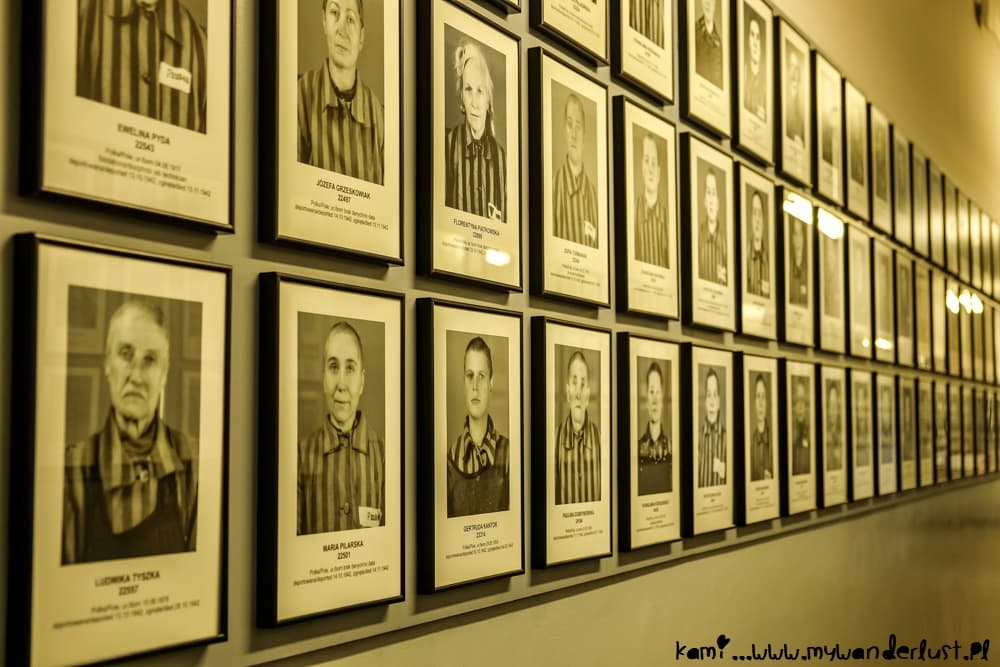
How to visit Auschwitz
You can visit Auschwitz two ways: with a tour from where you are staying in Poland (most likely Krakow, Katowice, Warsaw, or Wroclaw) or independently, reaching the site by car or using public transport. Both options are doable; however, the tour is a slightly better one as everything will be taken care of for you.
There is a wide selection of tours to choose from that depart from Krakow as well as other mentioned cities. Most of them cover more or less the same things: pick-up from your accommodation, transportation to/from Auschwitz and back, the entrance ticket to the concentration camp, and the guided tour on-site.
When I visited Auschwitz, I arrived by train from Warsaw, with the change in Katowice. I was at the museum almost an hour before my guided tour of the site was supposed to start, and despite the poor weather (it was raining on that day), there was no place to hide and wait for the tour. Visitors were not allowed to enter the museum until a few minutes before the tour was about to start. Me and a few other unlucky visitors just stood near the trees, hiding under the umbrella and waiting for our time to enter the site. I can’t say it was a comfortable situation (but at least the weather worked perfectly well for such a sad place to visit). Recently, a new visitors center was opened so hopefully the situation is better.
When using public transport, you need to rely on the schedule of trains/buses and, just in case, plan to be at the site with some extra time ahead; hence a tour is a better option. Still, visiting Auschwitz is doable independently – I did it, and once the tour of the site started, it was really good.

Visiting Auschwitz – practical information
Visiting Auschwitz memorial site is free of charge; however, I recommend joining the tour with the educator provided by the museum. They have a huge knowledge of the place and the tragedy that occurred here and can answer all the questions visitors always have. Tours are available in various languages: Polish, English, German, French, Spanish, Italian, Russian, Czech, and Slovak.
Even if you decide to visit the site independently, you still need to book the entry pass – those with free entrance start in the afternoon. You can buy/reserve your ticket online at the website of Auschwitz Museum here.
Currently, the price for the tour with the educator is 80 PLN for Polish and 90 PLN for other languages. When booking the ticket, you must state your full name and surname – this will be checked later.
Since tickets can sell out quickly, booking one at least a month in advance is recommended. If there are no tickets left for the day you want to visit Auschwitz, you can join the organized tour from Krakow or other cities, as tour operators usually have tickets booked in advance. Due to the sensitive nature of the place, children under 14 years old should not visit Auschwitz Museum.
Once you have your ticket, you need to arrive at the Auschwitz visitors center 30 minutes before your tour starts to go through the security check (it’s rather thorough, similar to the airport), have your ticket inspected (remember to have the ID or passport with you), get the headset for the tour and meet your group. You are allowed to have a bag or backpack with a maximum dimension of 30x20x10 cm; any larger luggage must be left in the paid lockers.
Auschwitz Museum is open every day except January 1st, December 25th, and Easter Sunday. Opening hours vary depending on the month and are as follows:
- 7:30-14:00 in December
- 7:30-15:00 in January and November
- 7:30-16:00 in February
- 7:30-17:00 in March and October
- 7:30-18:00 in April, May, and September
- 7:30-19:00 in June, July, and August
The closing time means the last entrance – after that, you are allowed to stay on-site for an hour and a half. However, if you want to see Auschwitz Museum properly, you need at least 3,5 hours for that – that’s also how long the standard tour with the educator lasts. It is usually divided equally between Auschwitz I and Auschwitz II- Birkenau. A free shuttle bus runs between the two sites every few minutes.
Taking pictures and making videos is allowed in Auschwitz, for individual use, except in two places: the hall with the hair of Victims (block nr 4) and the basements of Block 11. Your educator will remind you not to take pictures there.
Remember what sort of place you are visiting and behave there with respect. It might be obvious for most, but I can’t count how many times I’ve read news about inappropriate behavior in Auschwitz and other similar sites in Poland, so I think it’s worth reminding this is not your typical tourist attraction but a place of one of the greatest tragedy that ever happened in the world.

Getting to Auschwitz independently
If you decide to visit Auschwitz on your own, you must get to the visitors’ center, where your tour will start. The new visitors center, which opened just recently, is located at 55 Więźniów Oświęcimia Street in Oświęcim ( here is the exact location ). If you drive there, there is a large parking lot where you can leave your car before visiting the museum.
If you use public transport, there are both trains and buses you can take to reach Oświęcim. I recommend trains as they are slightly faster and more comfortable; however, some buses stop next to the museum, so that’s convenient. You can check all the connections on this website , where you can also find the location of the bus stop in Oświęcim (there can be three different ones).
The train station in Oświęcim is located at Powstańców Śląskich Street, some 20 minutes walking from the Auschwitz museum. It’s a straightforward way; you can check the map with the directions here . I recommend catching the train that gives you at least an hour between arriving at Oświęcim and when your tour starts.

Auschwitz tour from Krakow
Numerous Auschwitz tours depart from Krakow, so you will easily find the one that suits your itinerary and needs. Here are some recommended ones:
- Auschwitz-Birkenau Museum and Memorial Guided Tour from Krakow
- Auschwitz & Birkenau – Fully Guided Tour from Krakow
- Auschwitz-Birkenau Guided Tour with Private Transport from Kraków
- Auschwitz-Birkenau Guided Tour by Private Transport from Krakow
You can also combine visiting Auschwitz with Wieliczka Salt Mine , another UNESCO-listed site near Krakow and a must-visit place in Poland. Here are the tours that go to both places in one day:
- Day Trip to Auschwitz-Birkenau and Wieliczka Salt Mine from Krakow including Lunch
- Full-Day Tour of Auschwitz and Wieliczka Salt Mine from Krakow
- Auschwitz-Birkenau and Salt Mine Tour with private transport from Krakow
- Combined: Auschwitz Birkenau and Salt Mine private chauffeur from Krakow
If you decide to go to Auschwitz from Krakow on your own, you can take the train from the main train station to Oświęcim. They are rather frequent, more or less every hour, and the journey takes a bit over an hour (depending on the connection, the longest one is 1h20min).
If you want to take the bus, they depart from the MDA bus station, next to the main train station. The price for trains and buses is similar, between 15 and 20 PLN, although trains tend to be cheaper and faster. You can check all the connections and buy a ticket here .

Auschwitz tour from Warsaw
Even if Warsaw, the capital of Poland, is located over 300 km away from Oświęcim, it is possible to go for a one-day Auschwitz tour. However, you can expect a long day, and a large part of it will be spent traveling. But if you are visiting Warsaw only, Auschwitz can be a good addition to your Poland itinerary, so you can better understand the country’s complex history.
Here are some of the recommended Auschwitz tours from Warsaw:
- From Warsaw Auschwitz and Krakow one day tour by train with pick up and drop off
- One day tour to Auschwitz-Birkenau from Warsaw with private transport
Going for the day trip from Warsaw to Auschwitz independently is also possible using trains. You can take the 6 am train to Katowice and then change for the train to Oświęcim, arriving in the town around 10:30. If you decide to do that, you can book your Auschwitz tour for 11:30 or 12:00. On the way back, you can catch the train after 16:00 from Oświęcim to Katowice, and after changing for the train to Warsaw, you will be in the capital after 20:00.

Auschwitz tour from Katowice
Since Katowice is less than 40 km from Auschwitz, it’s easy to go for a day trip. You need to take the local train to Oświęcim, it takes less than 50 minutes, and the connections are more or less every hour.
Or you can go for a tour, here are the Auschwitz tours from Katowice:
- Auschwitz – Birkenau from Katowice
- Auschwitz & Birkenau English guided tour by private transport from Katowice
- Auschwitz tour from Wroclaw
Wroclaw is another popular place to visit in Poland, and since it’s located around 230 km from Oświęcim, you can go for an Auschwitz tour from Wroclaw too. If you decide to do it independently, you can take the train to Katowice and then change for the local train to Oświęcim. A one-way trip should take you less than 4 hours.
Or you can go for a tour; here are the recommended ones from Wroclaw:
- Auschwitz-Birkenau Tour from Wrocław
- Private Full-Day Tour to Auschwitz-Birkenau from Wroclaw
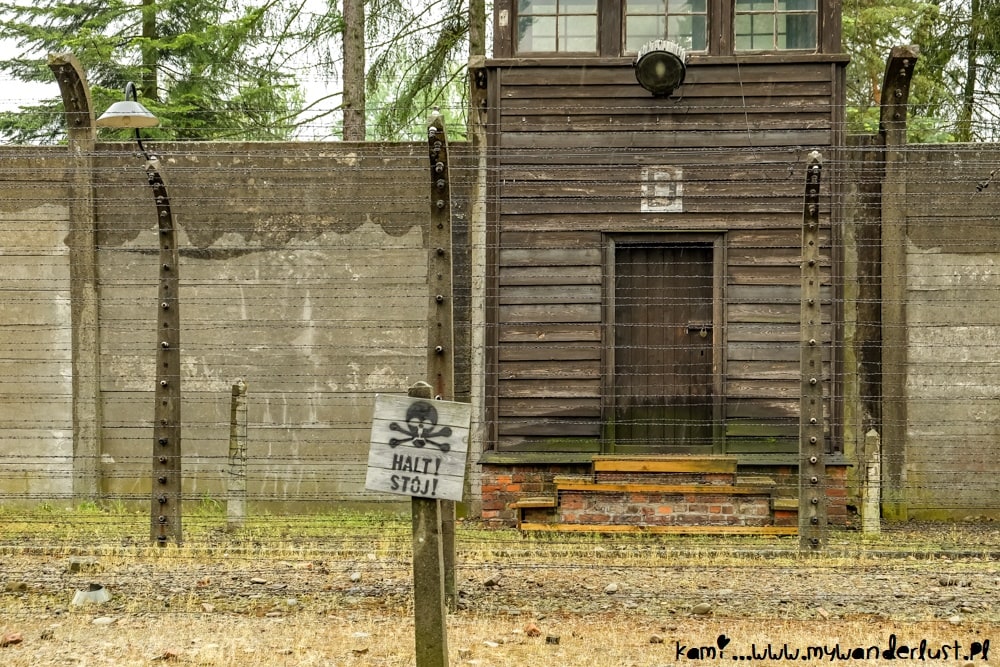
Auschwitz Museum Tour
As for the museum itself, here is what you can expect.
You will start in the oldest part of the concentration camp – Auschwitz I, where the infamous gate with the sign “Arbeit macht frei” (meaning “Work Sets You Free”) is located. Here, you will visit numerous barracks where inmates were kept – now you can see different exhibitions there, showing the reality of Auschwitz and halls with personal belongings taken from arriving prisoners – luggage, shoes, glasses, etc., or hair of Victims. You will learn all about cruel practices here, including medical experiments or torture.
Visiting this part of Auschwitz museum is a very somber experience, and it’s really difficult to comprehend the tragedy that happened in this very place.
Besides the barracks in Auschwitz I, you will also see where the camp commander lived or the first crematorium where Nazis started their experiments with killing using gas. In this part of the Auschwitz tour, you can take pictures everywhere except the two places in Blocks 4 and 11 – they will be clearly marked, and your educator will remind you about this restriction.
The visit to Auschwitz I takes around 1,5 hours. Afterward, together with your group and educator, you will take the shuttle bus to Auschwitz II-Birkenau, located some 3 km away.

Auschwitz II-Birkenau is where around 90% of victims died. It is a huge area that worked kind of like the killing factory, with four gas chambers and crematoriums. This is also where most prisoners arrived – you most likely know the view of the railway tracks and brick gate – that’s Auschwitz II-Birkenau. This part of the visit is mostly outdoors.
You will walk around the area, see the remnants of the camp, visit some barracks inside, and learn all about the horrific tragedy that happened here. When Auschwitz I has a more intimate, even claustrophobic feeling, Auschwitz II-Birkenau can overwhelm you with its scale and enormity.
You will spend around 1,5 hours here, too; afterward, you can take the shuttle bus back to the visitors center when you started your tour.
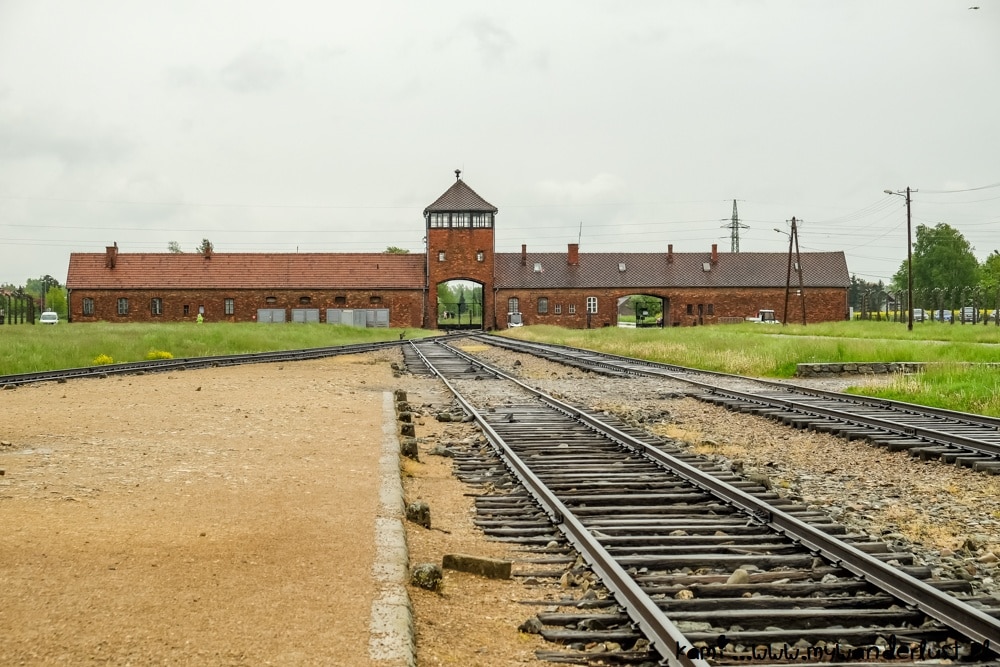
Final thoughts on visiting Auschwitz
Even though I’ve lived in Poland almost my whole life, and Auschwitz has been a familiar topic since I remember, it took me nearly 37 years to finally visit the place. Before I was in different Nazi Germany sites in Poland, mostly in Majdanek in Lublin, so I didn’t feel the need to visit Auschwitz too. But I don’t regret the decision to go there eventually.
You can read and learn about the place, but nothing can prepare you for visiting Auschwitz. Some areas look familiar (after all, pictures of the “Arbeit macht frei” sign or Birkenau gate are present everywhere), but you will still be overwhelmed by the place and seeing it in real life. It’s hard to comprehend the cruelty and tragedy that happened here, and dealing with all the thoughts invading your mind afterward can take a while. It can be one of the most difficult-to-understand places you will ever visit.
Still, despite it all, I think everyone should go to Auschwitz to see where fanaticism and totalitarianism can lead and why we should avoid them at all costs.
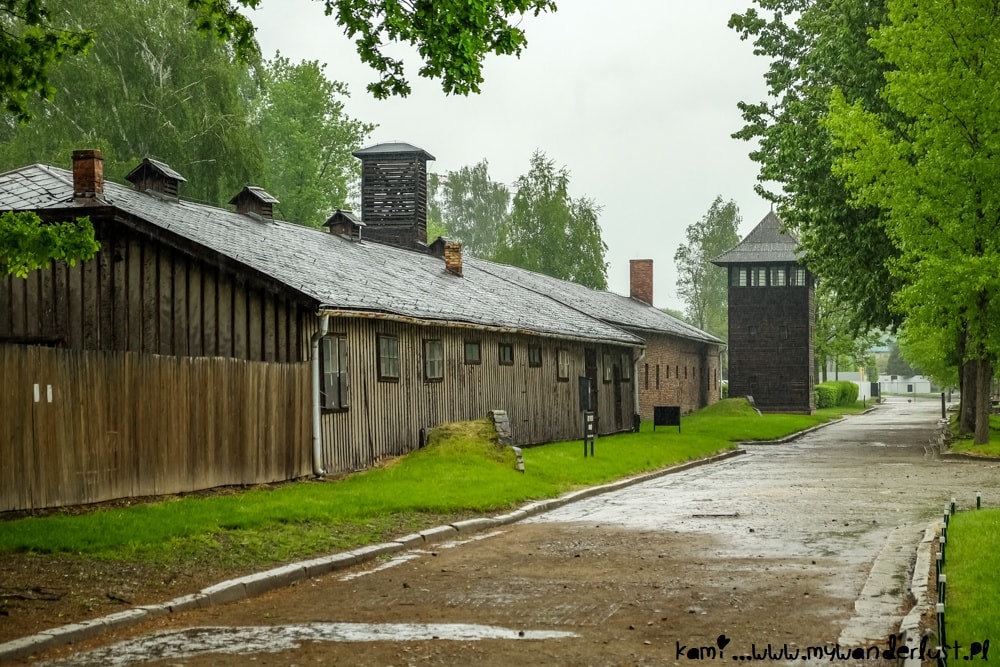
Travel Resources
You can find the best accommodation options at Booking . They have many discounts and excellent customer service. Click here to look for the place to stay in Poland
Never travel without travel insurance , you never know what might happen and better safe than sorry. You can check the insurance policy for Poland here.
I recommend joining organized tours to get to know the place better and to visit more places during your trip. You can find a great selection of tours at Get Your Guide – click here .
For the end I left a few announcements that might interest you:
- Sign up to my newsletter or follow me on Bloglovin to get updates about the new posts
- Join my Facebook group about Eastern Europe, the Balkans and former USSR and connect with fellow travellers and enthusiasts of these regions – just click here!
- I’ve included a few handy links of services and products I personally like and use so you can plan your own trip to Poland too. They are often affiliate links. This means I will get a small commission if you book/purchase anything through my links, at no extra costs for you. Thank you!
LIKED IT? PIN THIS POST FOR LATER!
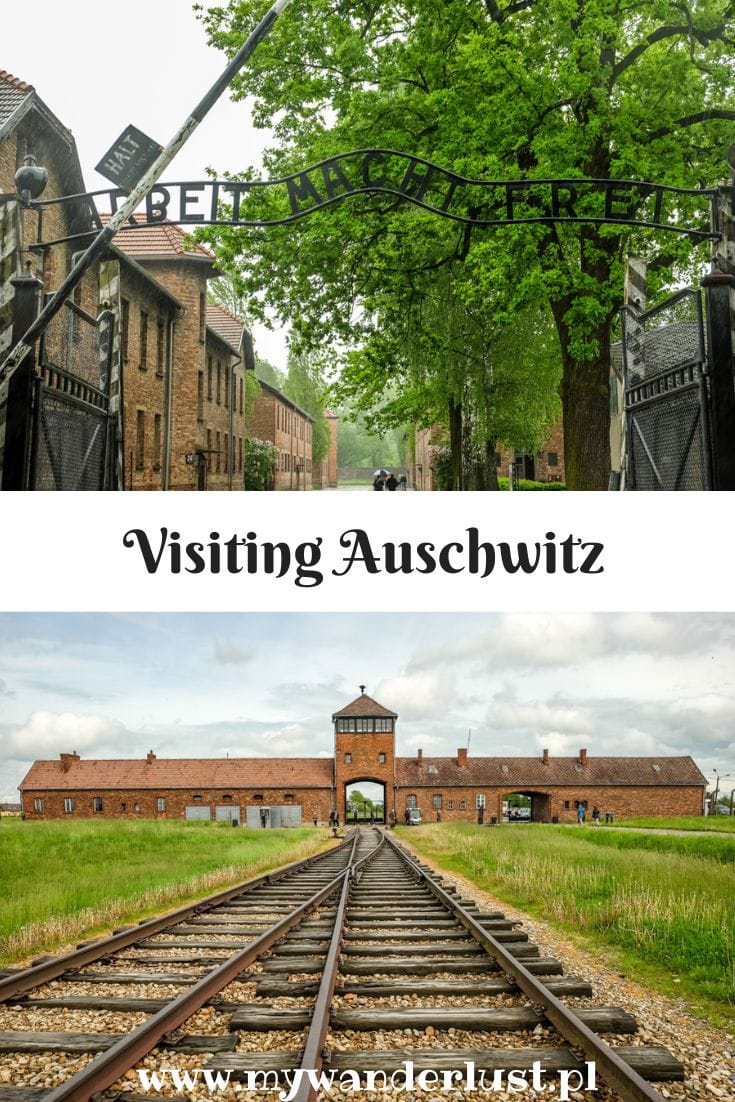
If you enjoyed that post why don't you share it with your friends? That would mean so much to me! Also be sure to join 30.000+ fellow travelers and follow me on Facebook , Twitter , or Instagram for travel updates and even more pictures! If you don't want to miss new posts sign up to my newsletter or follow on Bloglovin !

No Comments
Leave a reply cancel reply.
Sign me up for the newsletter!
Let’s become friends!
Join me on Facebook for even more travel updates!
Kami and the rest of the world

MEMORIAL AND MUSEUM AUSCHWITZ-BIRKENAU FORMER GERMAN NAZI CONCENTRATION AND EXTERMINATION CAMP
The post-camp relics are protected by the Museum created in 1947. The Memorial today is i.a. the Archive and Collections as well as research, conservation and publishing center.
- Auschwitz Council
- Preservation
- Historical collection
- Museum Reports
- Projects EU
- Museum Structure
- History of the Memorial
- Photo gallery
- Auschwitz prisoners
KL Auschwitz was the largest of the German Nazi concentration camps and extermination centers. Over 1.1 million men, women and children lost their lives here.
- Home Page - History
- Before the extermination
- Auschwitz I
- Auschwitz II
- Auschwitz III
- Auschwitz sub-camps
- Auschwitz and Shoah
- Categories of prisoners
- Fate of children
- Prisoner classification
- Life in the camp
- Punishments and executions
- Camp hospitals
- Medical experiments
- Informing the world
- The number of victims
- The SS garrison
- Holocaust denial
- Auschwitz Calendar
The authentic Memorial consists of two parts of the former camp: Auschwitz and Birkenau. A visit with an educator allows better understanding of this unique place.
- Home Page - Visiting
- Preparation and summary of a visit
- Reservation
- Tours options
- Online guided tours
- Rules for Visiting
- Opening hours
- Temporarily closed for visitors
- Getting to the Museum
- Permanent Exhibition
- National Exhibitions
- On-line Exhibitions
- Virtual tour
- Plan your visit
- Information plaques
There is no way to understand postwar Europe and the world without an in-depth confrontation between our idea of mankind and the remains of Auschwitz.
- Home Page - Education
- Study visits
- Educational projects
- Conferences
- Thematic sessions
- Exhibitions
- Visiting the Memorial
- Publications
- Volunteer Bureau
- Resources for teachers
- ICEAH – General Information
- Light of Remembrance
- Library - Online Catalogue

"Auschwitz. Not long ago. Not far away" exhibition in Boston
The travelling exhibition created by the Auschwitz Museum and the Spanish company Musealia was opened at The Castle at Park Plaza in Boston on 14 March. It will be on display there until 2 September.

Evil does not beget good, but good cannot be conquered. 79th anniversary of the liberation of Auschwitz.
On 27 January 2024, twenty Auschwitz and Holocaust Survivors took part in the commemoration of the 79th anniversary of the liberation of the German Nazi concentration and extermination camp. The event was held under the honorary patronage of the President of the Republic of Poland, Andrzej Duda.

"To reach people in the most remote corners of the world". The launch of the online tours of the Auschwitz Memorial.
"Auschwitz in Front of Your Eyes" is an application through which millions of people from around the world will gain access to education conducted directly from the authentic Memorial Site. It allows an online guided tour of the former German Nazi camp. Reservations: visit.auschwitz.org .

New online bookstore of the Museum
The new online bookstore of the Museum is now available at books.auschwitz.org . In addition to printed publications in many languages, ebooks are also available on the website.

New research laboratory of the Museum conservators
A new research laboratory was opened at the Auschwitz Museum. It will allow specialized research on objects from the German Nazi concentration and extermination camp Auschwitz.
The new laboratory is equipped to carry out physicochemical research and molecular biology analysis, including microbiology and genetics.

Today, once again, comes the time for essential human choices. 78th anniversary of liberation of Auschwitz.
On January 27, a group of 18 Auschwitz and Holocaust Survivors met at the former Auschwitz camp to commemorate the 78th anniversary of the liberation of this German Nazi concentration and extermination camp. The main theme of the anniversary was the process of planning, creating and expanding the system of dehumanisation and genocide at Auschwitz, which was particularly strongly defined by the words of survivor Marian Turski 'Auschwitz did not fall from the sky'.
ONLINE LIVE GUIDED TOURS OF THE AUSCHWITZ MEMORIAL FOR GROUPS AND INDIVIDUAL VISITORS

Memoria Magazine no. 78

Prof. Marc van Berkel appointed Honorary Consul of the Auschwitz Memorial in the Netherlands

Call for participants of the German-Polish seminar “How to Deal with Difficult Past?”

Camp chess pieces found in one of the historic buildings

Volunteers from the Brynek Forestry Technical School help protect the Museum's green spaces

Memoria Magazine no. 77

"A piece of the world surrounded by barbed wire..." The fate of Polish citizens in KL Auschwitz - a new temporary exhibition

The fate of the Sinti and Roma in KL Auschwitz - free study visits for young people

"The film would not have been possible without the Museum's cooperation.” Polish premiere of “The Zone of Interest".

Online educational session "The Image of Auschwitz in Mass Culture" – 29 February 2024
- Nasz profil na facebook
- via @auschwitzmuseum"> Udostępnij na Twitter
- Nasz profil na Pinterest
- Nasz profil na YouTube
Auschwitz Memorial / Muzeum Auschwitz
Wyświetl ten post na Instagramie. "Come here you free citizen of the world, whose life is safeguarded by human morality and whose existence is guaranteed through law. I want to tell you how modern criminals and common bandits have betrayed the morality of life and nullified the postulates of existence." - Zalman Gradowski, member of Sonderkommando at Auschwitz, murdered during the uprising on October 7, 1944. Auschwitz I. Block 27. Shoah exhibition. --- Photo by @tofudonbe --- #Auschwitz #Birkenau #AuschwitzMemorial #Nazi #Germany #concentrationcamp #extermination #genocide #history #Holocaust #Shoah #Jews #Poles #Roma #people #life #death #humanity #humiliation #dehumanization #remembrance #commemoration #memory #museum #Poland #igerspoland #UNESCO #worldheritage #worldHeritagelist @unesco #photography Post udostępniony przez Auschwitz Memorial and Museum (@auschwitzmemorial) Paź 27, 2019 o 11:17 PDT
Images from www.auschwitz.org may be used only in publications relating to the history of the German Nazi concentration and extermination camp Auschwitz-Birkenau or the activities of the Auschwitz Memorial. Their use must not tarnish the good reputation of the victims of KL Auschwitz. Any interference in the integrity of the images – including cropping or graphic processing – is prohibited. The use of the images for commercial purposes requires the Museum’s approval and information about the publication. Publishers undertake to indicate the authors and origin of the images: www.auschwitz.org, as well as to inform the Museum of the use of the images ([email protected]).
Auschwitz-Birkenau Memorial and Museum

Price & Hours
- Facilities 4.5
- Atmosphere 5.0
A 42-mile trip west of Kraków, the brutal, crushing concentration and extermination camps of Auschwitz I and Auschwitz II-Birkenau are located in the city of Oswiecim. More than 1.1 million people died in these camps' barracks, hospitals, gas chambers and labor fields.
Travelers say the Auschwitz-Birkenau Memorial and Museum is one of Europe's best preserved concentration camps. These camps, many add, are an important piece of history, although you'll feel emotional during your tour. As such, this locale is not ideal for younger children. Plan on bringing water and wearing comfortable walking shoes since you'll cover a lot of ground here. Also, reserve your timed entry passes and guided tours on the property's booking page well in advance.
The Auschwitz-Birkenau Memorial and Museum is free to visit every day between 7:30 a.m. and 3:30 p.m., but most months offer extended hours. (Note: Visitors will not be admitted up to 90 minutes before close.) Guided tours in English or any other language, however, will cost extra. General tours, the shortest option, last three-and-a-half hours and are 330 Polish zloty ($89) per person. These tours include permanent exhibits and the property's most important sights. For access to national exhibits, the Central Sauna and additional gas chamber and crematoria ruins, opt for the six-hour study tour; each ticket will set you back 510 Polish zloty ($138).
Restrooms, gift shops and cafes are available at both camps, and parking is provided for a fee. If you do not have a car, plan on joining an organized tour from local companies like Escape2Poland and KrakowTrip.com . (Tour prices, which start at $34 per person, include guide fees at the camps, plus transfers to and from Kraków.) More information about the Auschwitz-Birkenau Memorial and Museum is available on the property's website .
Tours & Tickets

Day Trip to Auschwitz-Birkenau and Wieliczka Salt Mine from Krakow including Lunch
(2772 reviews)
from $ 108.12

Krakow to Auschwitz-Birkenau Guided Tour with Ticket and Transfer
(2643 reviews)
from $ 33.42

Auschwitz-Birkenau and Wieliczka Salt Mine Guided Full Day Tour
(1488 reviews)
from $ 100.47
More Best Things To Do in Krakow

#2 Main Market Square (Rynek Glówny)
The Main Market Square (or Rynek Glówny, as it's known locally) is the world's largest medieval market square and the highlight of any trip to Kraków. It is the geographic center of the Old Town, the symbolic center of the city and, more than likely, the center of most of your trip plans.
The square is mostly about atmosphere – it is alive and bustling with locals and travelers alike, coming and going. You'll also notice the unsymmetrical towers of St. Mary's Basilica nearby, which are a great escape from the square's activity. If you'd rather buy some souvenirs, peruse the stalls at Cloth Hall.
Explore More of Krakow

Things To Do

Best Hotels

You might also like

# 2 in Best Eastern Europe Travel Spots

# 1 in Best Places to Visit in Germany

# 1 in Best Christmas Vacations
If you make a purchase from our site, we may earn a commission. This does not affect the quality or independence of our editorial content.
Recommended
The 50 Best Hotels in the USA 2024
Christina Maggitas February 6, 2024

The 32 Most Famous Landmarks in the World
Gwen Pratesi|Timothy J. Forster February 1, 2024

9 Top All-Inclusive Resorts in Florida for 2024
Gwen Pratesi|Amanda Norcross January 5, 2024

24 Top All-Inclusive Resorts in the U.S. for 2024
Erin Evans January 4, 2024

26 Top Adults-Only All-Inclusive Resorts for 2024
Zach Watson December 28, 2023

Solo Vacations: The 36 Best Places to Travel Alone in 2024
Lyn Mettler|Erin Vasta December 22, 2023

26 Cheap Beach Vacations for Travelers on a Budget
Kyle McCarthy|Sharael Kolberg December 4, 2023

The 50 Most Beautiful White Sand Beaches in the World
Holly Johnson December 1, 2023

The 26 Best Zoos in the U.S.
Rachael Hood November 16, 2023

44 Cheap Tropical Vacations That Feel Expensive
Holly Johnson|Alissa Grisler November 10, 2023

Oświęcim (Auschwitz-Birkenau)
Book your individual trip , stress-free with local travel experts
- roughguides.com
- southern-poland
- oswiecim-auschwitz-birkenau
- Travel guide
- Local Experts
- Travel Advice
- Accommodation
Lying 70km west of Kraków and within easy day-trip range, the complex of camps known as Auschwitz-Birkenau ( auschwitz.org ) has become synonymous with World War II and the Holocaust. The camps lie on the western fringes of Oświęcim , which is in all other respects a perfectly nondescript middle-sized Polish town. Auschwitz was established by the Germans in 1940 to house Polish political prisoners but swiftly expanded to accommodate Soviet POWs. The Birkenau annexe, built in 1941 to cope with growing numbers, became the site of one of the Nazi regime’s most notorious death camps: about 1.3 million people, 90 percent of them Jews, were murdered here. The Germans failed to destroy the camp before they left and over 60,000 prisoners survived – which is why the horrors perpetrated here are so well documented. The two sites, Auschwitz and Birkenau, are 3km apart, but are linked by shuttle bus. Together they are visited by over 1.3 million visitors a year.
You can catch one of the regular buses (2–3 every hour; 1hr 40min; 10zł) to the main camp from Kraków’s PKS Terminal. There’s an hourly shuttle-bus service to the Birkenau section from the car park at Auschwitz from April to October. Taxis are also available; otherwise it’s a 3km walk.
Tailor-made travel itineraries for Poland, created by local experts

11 days / from 1598 USD
Explore the Liberation Route in Poland
Poland was the first country that Hitler invaded and with it starting World War II. Discover the Polish sites of World War II with this itinerary, from the Northern city of Gdansk where the first battle took place to the concentration camps of Auschwitz close to Krakow.
Tailor-made trips for Poland
Most visitors start at Auschwitz (daily 8am–dusk; guided tour 40zł, non-guided visits free; English-language tours depart on the hour 9.30am–3.30pm), which is 3km west of Oświęcim town centre. From May to October participation in guided tours is compulsory between 10am–3pm, so if you want to visit the Auschwitz site on your own, arrive outside these times. Once beyond the entrance gate (bearing the notorious cast-iron inscription Arbeit Macht Frei ), the site consists of a series of red-brick barrack blocks, many of which contain a museum display relating to a particular aspect of the camp or a particular nation whose citizens were deported here. Block 13 contains an account of Europe’s Roma and Sinti communities (an estimated 20,000 of whom died here); block 5 contains rooms full of spectacles, prosthetic limbs, pots and pans, all confiscated from inmates of the camp and abandoned here when the Germans retreated. The prison blocks finish by a gas chamberand a pair of ovens where the bodies were incinerated.
The huge Birkenau camp (same hours as Auschwitz) was designed as a death camp in 1942, when the Nazis decided on their policy of exterminating European Jewry. Allow 1–2 hours to fully explore the 175-hectare site. Large gas chambers at the back of the camp were damaged but not destroyed by the fleeing Nazis in 1945. Victims arrived in closed trains, and those who were fit to work (around 25 percent) were immediately separated from those who were driven straight to the gas chambers. The railway line is still there, just as the Nazis abandoned it. One of the few buildings still standing here is the so-called "Sauna", where the newly arrived were undressed, shaved and assigned camp clothes – a matter-of-fact museum display takes you methodically through the process.

Discover more places in Poland

- Travel Guide Morocco
- Travel Guide Namibia
- Travel Guide South Africa
- Travel Guide China
- Travel Guide India
- Travel Guide Indonesia
- Travel Guide Japan
- Travel Guide Laos
- Travel Guide Malaysia
- Travel Guide Myanmar (Burma)
- Travel Guide Nepal
- Travel Guide Philippines
- Travel Guide Singapore
- Travel Guide South Korea
- Travel Guide Sri Lanka
- Travel Guide Taiwan
- Travel Guide Thailand
- Travel Guide Australia
- Travel Guide Fiji
- Travel Guide New Zealand
- Travel Guide Belize
- Costa Rica Travel Guide
- Travel Guide Cuba
- Travel Guide Guatemala
- Travel Guide Honduras
- Travel Guide Jamaica
- Travel Guide Nicaragua
- Travel Guide Panama
- Travel Guide Puerto Rico
- Travel Guide Trinidad and Tobago
- Travel Guide Albania
- Travel Guide Austria
- Travel Guide Belgium
- Travel Guide Bosnia-Herzegovina
- Travel Guide Bulgaria
- Travel Guide Cyprus
- Travel Guide Czechia (Czech Republic)
- Travel Guide Denmark
- Travel Guide England
- Travel Guide Estonia
- Travel Guide Finland
- Travel Guide France
- Travel Guide Germany
- Travel Guide Greece
- Travel Guide Hungary
- Iceland Travel Guide
The Rough Guides to Poland and related travel guides
In-depth, easy-to-use travel guides filled with expert advice.

Find even more inspiration here

Planning your own trip? Prepare for your trip
Use Rough Guides' trusted partners for great rates
written by Rough Guides Editors
updated 26.04.2021
Ready to travel and discover Poland?
Get support from our local experts for stress-free planning & worry-free travels.
- Where to stay
- Travel advice

Auschwitz-Birkenau
Travel guide.
- Things to Do
- Best Hotels
- Things to See
- Planning a Trip
Things to Do in Auschwitz-Birkenau
A trip to Kraków provides an excellent opportunity to visit the former Nazi concentration and extermination camps at Auschwitz ( Oswiecim in Polish) and Birkenau. The camps lie about 80km (50 miles) to the west of the city and can be visited in an easy daytrip. Getting there is relatively straightforward. There are regular train and minibus services that make the journey in about 90 minutes. Additionally, several tourist agencies run coach tours; these usually include transportation from Kraków's main square and an English-language guide once you've arrived at the camps. If you're not completely up on your WWII history, this is one place where taking a guided tour makes sense to get the most out of the experience.
Getting there may be easy, but taking in the experience is anything but. Auschwitz-Birkenau was Nazi Germany's most notorious death camp and has come to be seen as a symbol of the Holocaust itself. The exhibits are in turn shocking and profoundly depressing. At the end of the day, as you're slogging through the immense open fields at Birkenau, where hundreds of thousands of Jews, as well as Poles, POWs, and political prisoners of many nationalities, were held before meeting their ends in gas chambers just yards away, you'll find yourself wallowing in a mix of despair and disgust. Kraków's colorful square, filled with people laughing over their coffees, seems a million miles away.
At the same time, there are powerful reasons for coming here, including bearing witness to this epic human tragedy. Alongside the exhibits of yards of human hair of the victims or empty canisters of Zyklon-B gas that was used as the killing agent, you'll also see rows and rows of photographs of those who died here and learn part of the story of where they came from, how they got here, and what they went through. It's no exaggeration to say this is likely to be the most moving experience you'll have in Poland, and the impressions you form here will last a lifetime. That said, Auschwitz is no place for children. If you're traveling with children younger than 14 or so, it's best to skip the camps altogether.

- All Regions
- Australia & South Pacific
- Caribbean & Atlantic
- Central & South America
- Middle East & Africa
- North America
- Washington, D.C.
- San Francisco
- New York City
- Los Angeles
- Arts & Culture
- Beach & Water Sports
- Local Experiences
- Food & Drink
- Outdoor & Adventure
- National Parks
- Winter Sports
- Travelers with Disabilities
- Family & Kids
- All Slideshows
- Hotel Deals
- Car Rentals
- Flight Alerts
- Credit Cards & Loyalty Points
- Cruise News
- Entry Requirements & Customs
- Car, Bus, Rail News
- Money & Fees
- Health, Insurance, Security
- Packing & Luggage
- -Arthur Frommer Online
- -Passportable
- Road Trip Guides
- Alaska Made Easy
- Great Vacation Ideas in the U.S.A.
- Best of the Caribbean
- Best of Mexico
- Cruise Inspiration
- Best Places to Go 2024
What to expect on your visit to Auschwitz
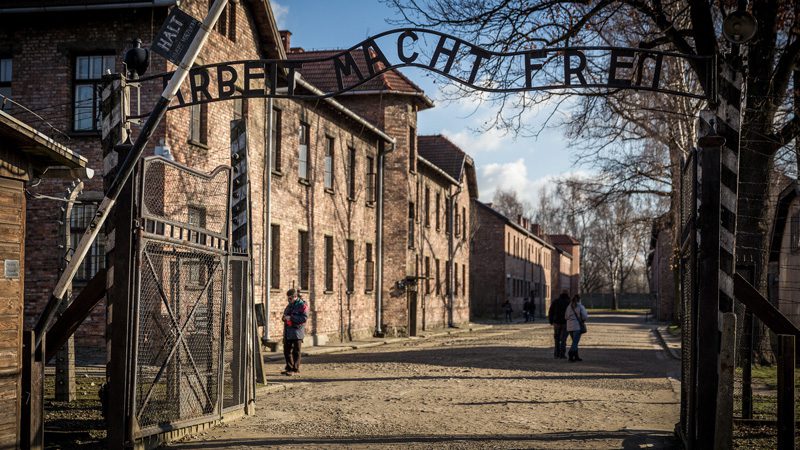
A couple of years ago, my girlfriend and I were hostelling our way through central Europe. We’d made it to Berlin, which is a little like those crossroads in movies, the ones with a dozen signs pointing in every possible direction.
There were too many choices as to what to do next. We could head north into Denmark, west to the Netherlands and Belgium, or south into the Czech Republic.
“What about Poland?” my girlfriend said. “We could see Auschwitz.”
The drive from Krakow
A couple of days later I was bouncing along in a small bus through the green lanes of southern Poland, just outside Krakow. The driver didn’t speak any English, nor did the other four sullen Poles on board. When we mentioned the word Auschwitz the driver just grunted and gestured to the seats.
The drive from Krakow to the old camp doesn’t take long. After thirty minutes we stopped on a road like any other road. A few of us got off and the bus rumbled away. Opposite was a shady boulevard lined with birch and oak trees. Glance up and you could just make out the red bricks and roofs of Auschwitz I, the original camp built by Polish political prisoners in the early 1940s.
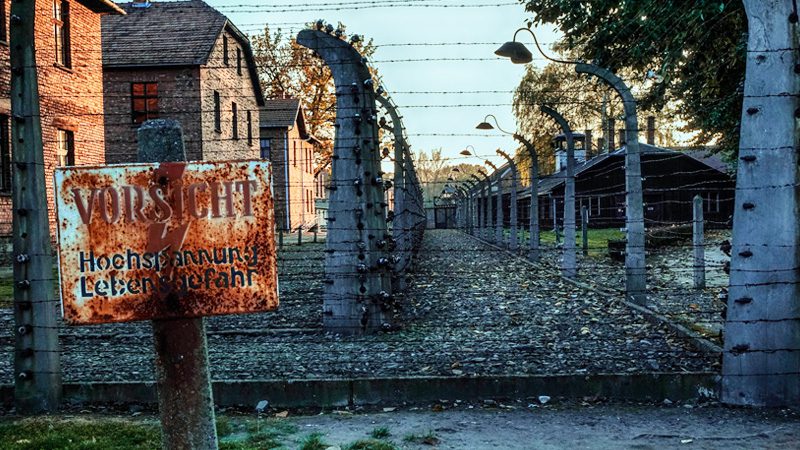
Auschwitz I. Image Thomas Hee, Flickr
Auschwitz I
On busy days, over 30,000 tourists will walk through the grounds of Auschwitz. Dozens and dozens of tours run simultaneously through the old camp and Birkenau, a few minutes down the road. As such, they run a pretty efficient ship. When you arrive you sign up for a tour time and are equipped with a pass, headset and radio. Your guide has a microphone and a transmitter, so all you need to do is tune in to their frequency. You begin where so many prisoners once did, beneath the rusted metal words “Arbeit macht frei” (work makes you free).
The next few hours are hard to describe. Your guide leads you through the avenues and neat brick houses of Auschwitz I. There are bare dormitories, old corridors, chilly parade grounds and – everywhere – double lines of razor wire poles, each equally spaced from its neighbour, and arched in a candy cane curve.
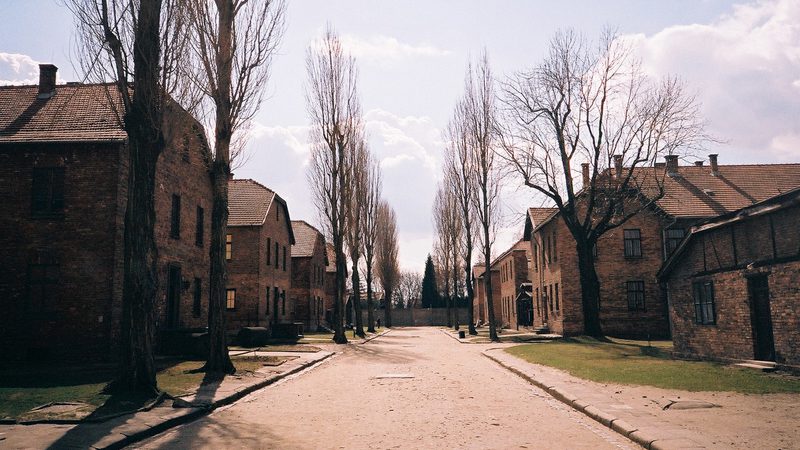
Image c/o Monica Kelly, Flickr
In every room, rows and rows of faces stare out from the walls: old prisoner profiles in black and white. Most look blank and empty; they portray nothing. But studying them is worth the price of admission alone. You could look at the eyes for hours, searching for a glimmer of hope, a pang of fear or a hint of determination. You can’t help but wonder what they were thinking.
Your guide says, “Three weeks after these were taken, all these people were dead.”
Every piece of the place has a story attached. Here a room, three feet by three feet, where four men were made to stand in the dark until they died. There the square outside notorious Block 11, the prison within a prison, where inmates were routinely executed against a brick wall. The house of the camp commandant, Rudolf Hoss, and the gallows where he was executed by the Allies in 1947. The gas chambers, the piles of hair, glasses, shoes… children’s toys.
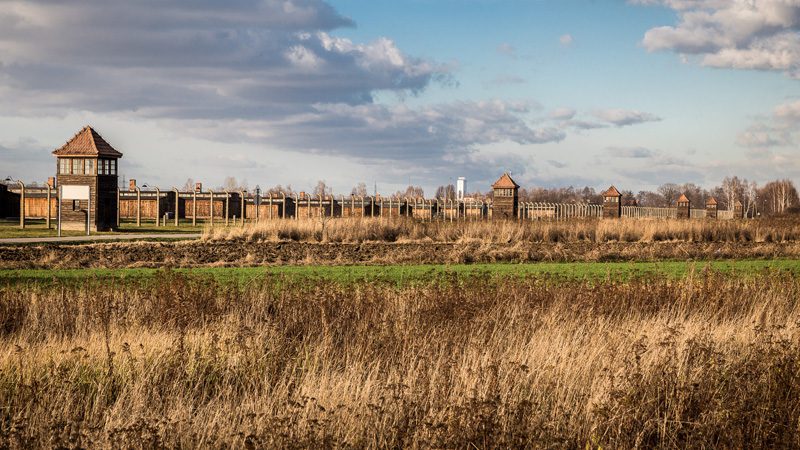
The fields of Birkenau. Image Mattia Panciroli, Flickr
Tourism in Auschwitz has attracted some criticism in recent years (the alleged ‘death tourism’) but I don’t really buy into it. You can criticise the actions of individuals, sure, but I think educating and illuminating future generations on one of the darkest times in human history can only be a good thing. Just like Winston Churchill said: “Those who do not learn from history are doomed to repeat it.”
After the original camp, the tour moves to Birkenau, which is an experience in itself. The close streets and heaviness of Auschwitz I are replaced by acres of grass, clear skies and two parallel railway tracks that come to an ominous, and very final, stop. There’s a warped tranquillity in Birkenau. Yellow wildflowers grow beneath the guard towers. You can see nearby villages and rolling hills. There’s the warble of distant birdsong. It’s hard to imagine that up to 20,000 people per day were killed and burned here. Apparently the nearby residents, the ones who hadn’t been rounded up in the first few years of Nazi occupation, could see and smell the smoke for miles. They slept with the distant glow of the ovens outside their window.
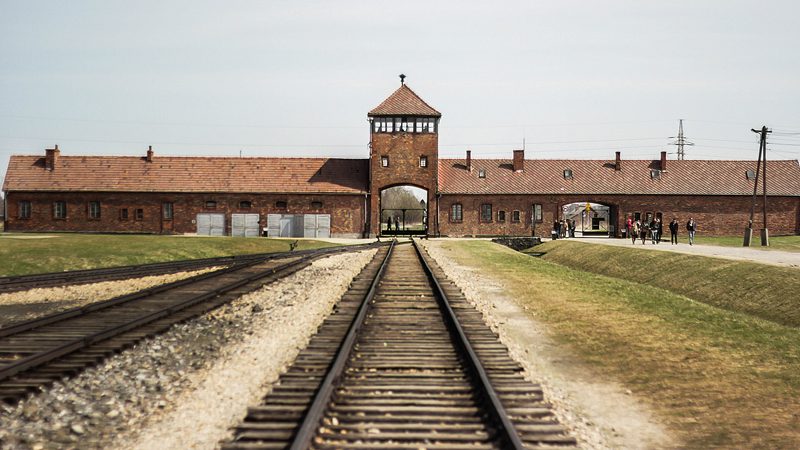
Image c/o Nick Perrone, Flickr
A visit to Auchwitz is the difference between reading the music and hearing it played. You can read about the horrors that happened there, watch documentaries that give you all the facts, but until you stand in the gas chambers, hear the eerie silence around the ash pools of Birkenau and see the dusty wooden bunks where prisoners would huddle together – you won’t understand it.
At the end of the tour you’re left standing outside the red brick main entrance to Birkenau. I remember thinking how quiet the place was. Even with so many people in it. there was so much silence in that place.
Travellers can visit Auschwitz on some of our trips through Poland . All entry fees to the World Heritage Site go towards preserving the camp for future generations.
Feature image c/o Matti Panciroli, Flickr

Feeling inspired?
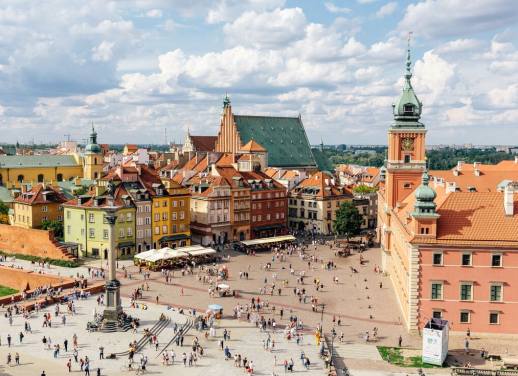
James Shackell
I was born in 1987 and aged from there. I like the sound of pop-rocks and dislike the sound of styrofoam. The length of my forearm is approximately the same as the length of my shin. My favourite Beatle is Ringo. I believe that junk food tastes so good because it’s bad for you and that your parents did the best job they knew how to do. If Johnny Cash wrote a song about my travels it would be called ‘I’ve been to several places but still have many other destinations on my to-do list, man’. Sometimes I have trouble finishing sen
You might also like
Galapagos or madagascar which unique destination should be..., travelling to chile here’s the best time to..., 10 reasons to visit samoa, the 10 antarctica questions you want answered, australia or new zealand where to go on..., 10 epic spots to stop at on your..., small group travel vs coach tours: which style..., costa rica or mexico: which country to check..., 7 of the best destinations for solo travellers..., machu picchu or chichen itza which historical site..., the people you meet: the art of connecting....

15 Top-Rated Tourist Attractions in Poland
Written by Diana Bocco Updated Oct 14, 2022
Poland is a historical country with 14 UNESCO World Heritage Sites and a collection of breathtaking natural attractions – mountains, national parks, rugged coastlines, and some unexpected wonders such as the world's oldest salt mine.
With its medieval architecture, troubled WWII history, and many villages that seem to be stuck in time, Poland is the perfect destination for history buffs and architecture lovers. Packed with things to do, Poland's cities are humming with the energy of art and culture and are a great starting point to discover everything the country has to offer.
No matter if you're after history, art, or nature, plan your visit with our list of the top tourist attractions in Poland.
1. Wieliczka Salt Mine, Wieliczka
2. auschwitz-birkenau camps, oswiecim, 3. warsaw old market place, warsaw, 4. malbork castle, malbork, 5. lazienki park, warsaw, 6. schindler's factory, krakow, 7. crooked forest, gryfino, 8. warsaw rising museum, warsaw, 9. wawel royal castle, kraków, 10. wolf's lair, gierloz, 11. morskie oko lake, tatra national park, 12. kraków cloth hall, krakow, 13. wawel cathedral, krakow, 14. slowinski sand dunes, 15. biskupin settlement, map of tourist attractions in poland.
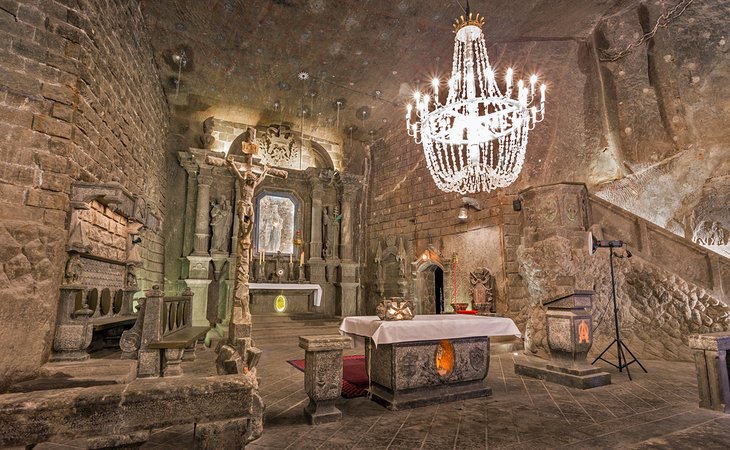
The 13 th -century Wieliczka salt mine is just as important for the locals today as it was hundreds of years ago, but for a very different reason. One of the world's oldest and longest-working salt mines, it stopped commercial operations in 1996 and has since become an artistic attraction .
The Wieliczka Salt Mine is now home to four chapels, corridors, and statues – all carved out of the rock salt walls. The mine's original shafts and passageways – some as deep as 327 meters underground – have been reopened and allow visitors to explore pits and chambers, walking past statues and alongside stunning architectural marvels. Deep into the mine, an underground lake shimmers against the candlelit walls.
The main tourist attraction inside the mine, however, is the Chapel of St. Kinga, a 12-meter-high chamber where everything – including the elaborate chandeliers and furniture – are made of salt. The tour continues on to the Erazm Baracz Chamber, where you'll find a lake that's saltier than the Dead Sea, and ends at a museum that explains salt mining and what life in the mines was like.
Official site: https://www.wieliczka-saltmine.com/
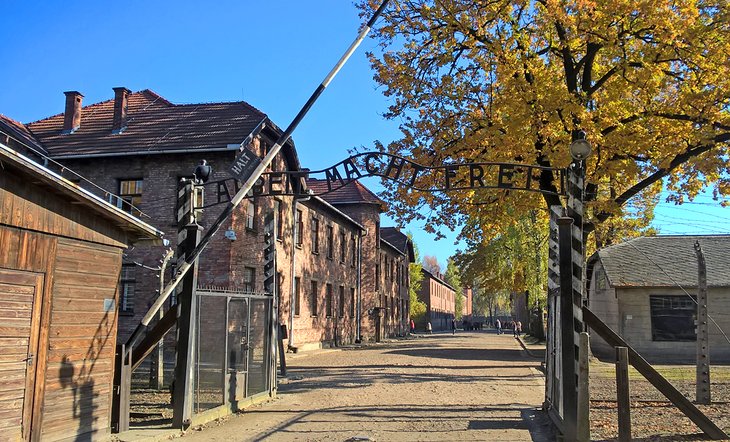
The Auschwitz I and the Auschwitz II—Birkenau concentration camps are a different kind of must-see. Located about an hour west of Krakow, the camps offer a sobering look into the past.
Between 1942 and 1944, over 900,000 Jews were brought to the camps here from German-occupied countries. Political prisoners, Roma, and a number of other ethnicities were also sent here. Less than 10 percent of the people brought here survived their stay.
At the end of the war, as Soviet forces advanced into Poland, the Nazis destroyed the gas chambers and crematoria before fleeing. Although they managed to destroy and burn down part of the camp, many structures remain standing to this day.
The camps, which include over 300 barracks and hundreds of other buildings and crematoriums, can only be explored as part of a guided tour.
Official site: http://auschwitz.org/en/
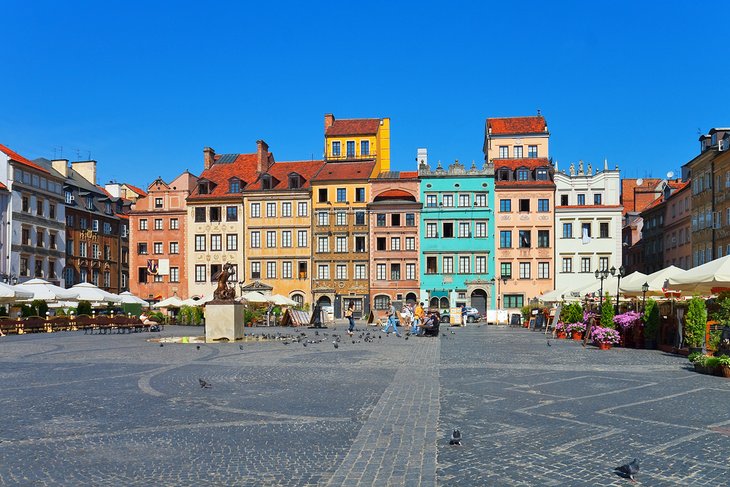
The oldest part of Warsaw, the Old Town Market Place dates back to the 13 th century. Although 85 percent of the area was destroyed by the Nazis during World War II, it has since been restored to look exactly like it did when it was first built.
A mix of medieval architecture, Gothic, and colorful Renaissance buildings and merchant houses all coexist in the city's most popular square. The 19th-century bronze statue of a sword-wielding mermaid – a symbol of Warsaw's since medieval times – survived the War and still stands at the square.
Today, the Market Square is home to many cafés and restaurants, as well as street art sellers and many souvenir stalls. The main branch of the Historical Museum of Warsaw is also located here – home to a massive art collection but also a look through the history of the city and country.
The Adam Mickiewicz Museum of Literature , just steps away, pays homage to Poland's most famous poet and writer.
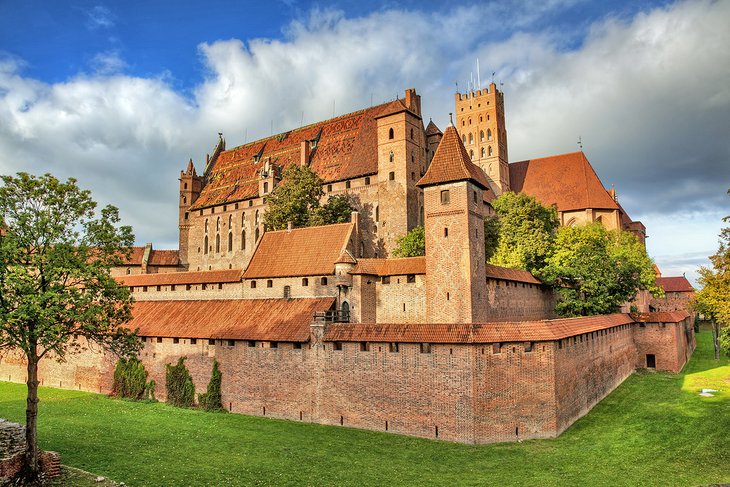
This 13th-century Teutonic castle was originally built by the Teutonic Knights, a religious order that served as a crusading military unit. Although the castle started as a small fortification, it was subsequently expanded over the centuries and eventually became a massive structure. Once the largest Gothic building in Europe, Malbork castle remains the world's largest castle by land area.
Today, the castle serves as a museum, with many of its original rooms perfectly preserved. Highlights include a medieval kitchen with a six-meter-wide fireplace, a collection of armor and weapons, and the knights' private toilet at the top of a tower.
In addition to historical collections, the castle also houses a number of exhibits, including one showcasing the conservation techniques used to restore the castle.
Official site: http://www.zamek.malbork.pl/en
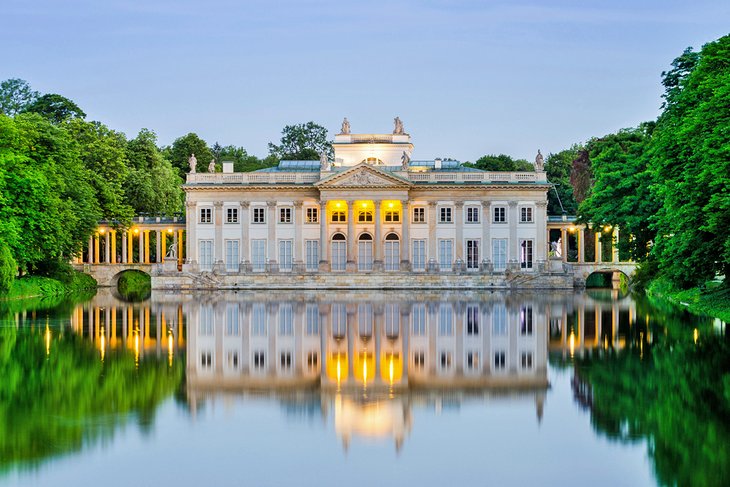
Lazienki Park covers 76 hectares of the city center, making it one of Poland's largest urban parks . Lazienki started life as a baths park for a nobleman in the 17 th century. Today, the Palace on the Isle is open to the public, as are the gardens around it.
A Classical-theater isle stage (where performances are still held), a number of smaller palaces and structures that now serve as museums or galleries, and even a classicist temple dedicated to the goddess Diana are set in the gardens.
A large statue of classic Polish composer Frederic Chopin stands on the grounds of the park as well. The statue was purposely destroyed by German forces as they invaded Poland during WWII and reconstructed in 1958 using the original mold. Every Sunday afternoon, free piano concerts are held at the foot of the statue.
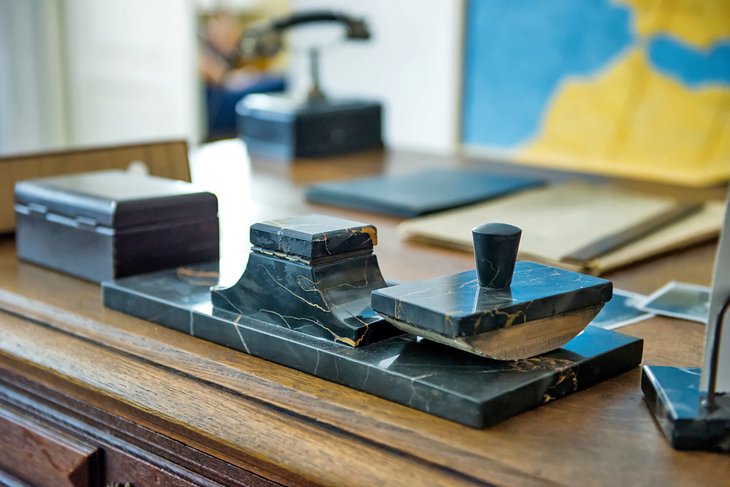
Oskar Schindler's enamel and metal factory – made famous by Steven Spielberg's 1994 movie – is now home to two museums. Part of the building has been converted into the Museum of Contemporary Art, while Schindler's former office – and much of the former factory floor – is now a branch of the Historical Museum of the City of Krakow.
Schindler's former office, which has been preserved intact since War times, is now an exhibit dedicated to his life and the lives of the people he saved in this very factory. In the office, a wall of glass known as the "Survivors' Ark" serves as a time capsule, full of enamel pots like the ones built at the factory.
The rest of the factory presents a number of cinematic exhibits that show Krakow during the War and the impact the Nazis had on the history of the city and the lives who inhabited it. There are also a number of immersive stage-like reconstructions of 1940s spaces – from a typical street to the seats of a tram to a typical Jewish apartment of the time.
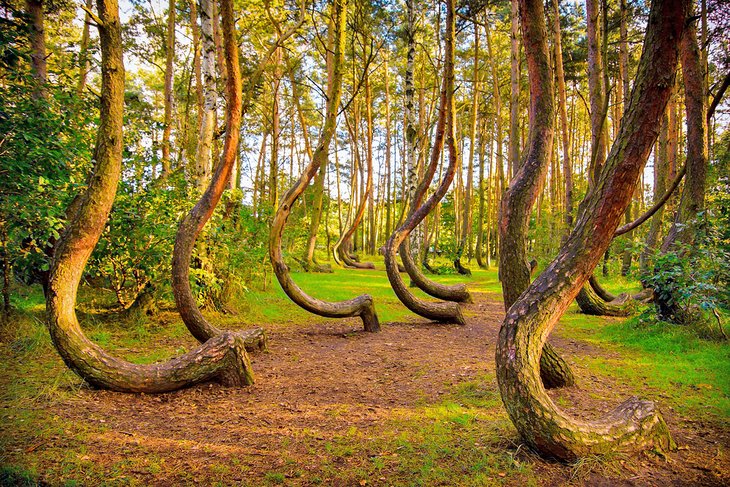
Located just outside the tiny town of Gryfino, the Crooked Forest is a (perhaps) natural marvel that defies explanation. Here, a number of pine trees stand on their own, growing with a 90-degree angle at their base, all bent northward.
The pines were originally planted here in the 1930s, but it took about 10 years before the trunks started to show their characteristic bent. Despite many theories, there's a standing heated debate on whether the curvature was created artificially by manipulating the trees – or whether it just happened naturally or accidentally.
Regardless of the cause, the eerie presence of the trees is hard to deny, especially as the rest of the forest is full of healthy, perfectly straight pine trees. It's a great place for a quiet hike in the silence of the forest.
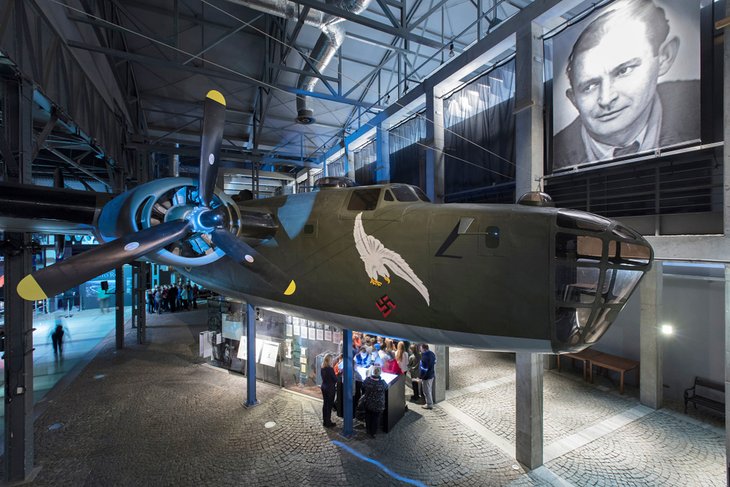
This is a museum dedicated to 1944's Warsaw Uprising, where the Polish Underground Resistance fought the German occupation of their city. The uprising lasted for 63 days, with massive casualties on both sides.
Once the Polish forces surrounded them, the Nazis systematically destroyed a large number of historical buildings and structures in retaliation. The uprising was a massive effort by a poorly equipped and barely armed group of civilians trying to defeat the enemy – and the museum has done a remarkable job of bringing that spirit to life.
Exhibits here include many rooms and events brought to life through films, artifacts, recreations, and interactive displays, including replicas of the sewer tunnels used to move around the city in secret, an insurgent hospital, and a print shop where you can see posters and underground newspapers.
Several rooms show continuous original footage of the events, and there's a special section dedicated to the Nazi occupation and the atrocities committed during the uprising.
Official site: https://www.1944.pl/en/
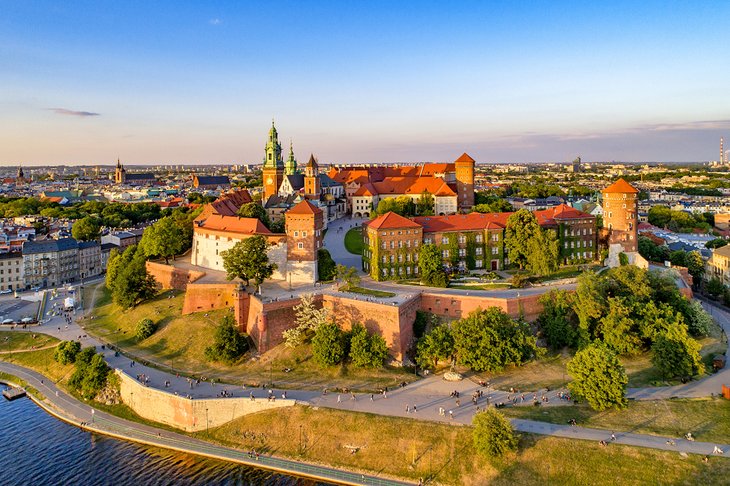
Wawel is an architecturally eclectic castle – the construction has medieval elements mixed with Baroque and Renaissance details. One of the first places to be declared a UNESCO World Heritage Site in Poland, the castle has always been an important part of the history of the country.
King Sigismund I the Old, who lived in the castle in the 16 th century, was an avid collector of art – so it makes sense that the castle is now an important art museum, focused mainly on paintings and curatorial work.
Additional collections include weapons and armor, porcelain and ceramics, lots of textiles and prints, and a significant amount of period furniture. The museum also has an unusually large collection of Ottoman tents, the largest of its kind in Europe.
Official site: https://wawel.krakow.pl/en
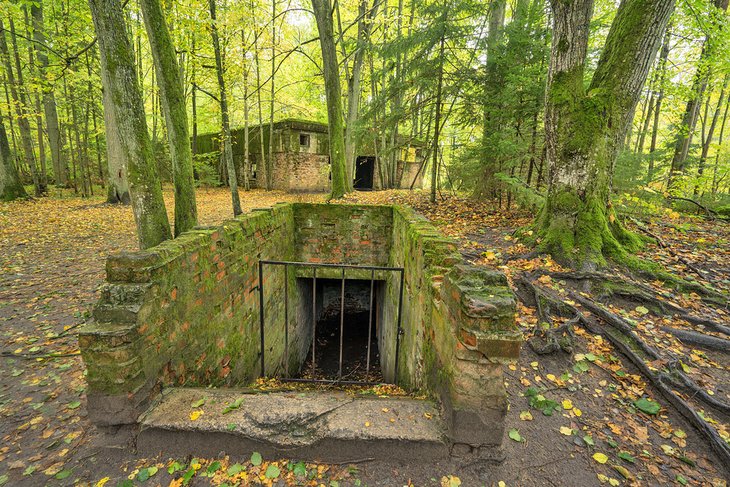
Hitler's top-secret military headquarters is hidden deep in the Masurian woods. When it was active, it had three fortified security areas around it, defended by land mines in addition to heavily armed units.
At the time, the area included over 80 buildings, including several air-raid shelter bunkers and watchtowers. The Nazis blew up the complex in 1945 before fleeing the approaching Soviet Forces, but some of the buildings were so heavily reinforced, many of them could not be destroyed.
Visitors can now make their way to the area as a day trip from Warsaw . Although there are plans to eventually add historical exhibits or even a museum to the area, for now it's more a collection of ruins to walk through, discovering the corners of the history that developed here.
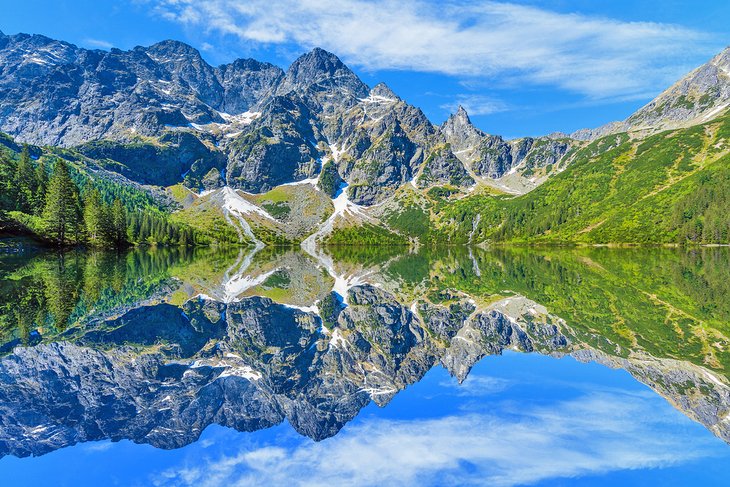
Located deep within the Tatra National Park and surrounded by towering mountains and Swiss pines, the lake is a favorite destination for people of all ages. Reaching it requires an easy but long paved hike through shaded forests. The lake changes color throughout the year, transforming from a deep shade of blue to a softer turquoise hue.
The Tatras National Park extends through both Poland and Slovakia. In Poland, it's home to over 600 caves; snow-covered peaks; and a number of waterfalls, including the 70-meter-tall Wielka Siklawa.
Most of the park is hikeable, with over 270 kilometers of trails of all lengths and difficulties.
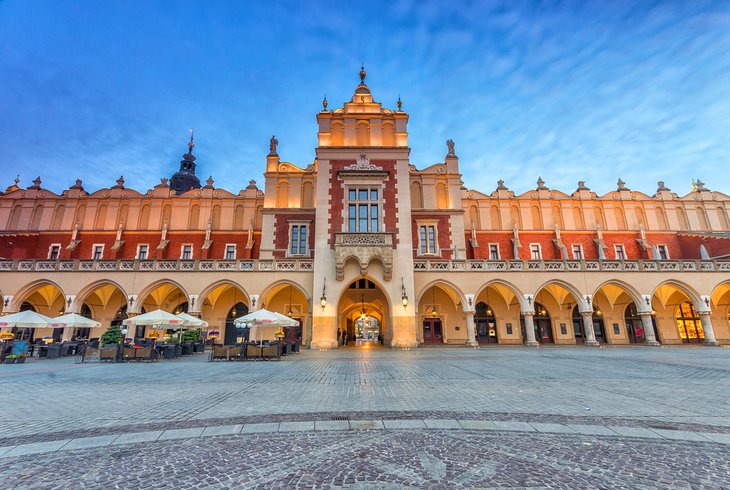
The Hall, which dates back to the Renaissance, has always been the heart of international trade in Poland. During the 15 th century, it was the main place for foreign merchants to gather to sell exotic spices from the East.
Traders from all over Europe also came here to buy salt from the Wieliczka Salt Mine. Textiles, leather, and silk were also traded here – imported from other countries for sale and produced locally.
The Hall was renovated in the 19 th century and used for years as an events center, where formal balls to honor visiting emperors and kings were held. The main floor is now again a center of commerce, with small stalls and galleries selling souvenirs, collectibles, and small pieces of art.
The Sukiennice Museum has taken over the second floor – home to a large collection of 19th-century Polish art.
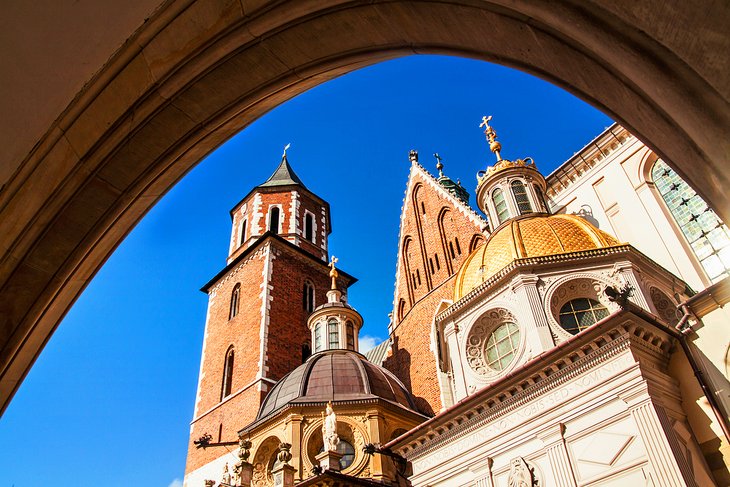
The first Wawel Cathedral was built over 1,000 years ago, though the current one – a fascinating combination of Romanesque, Baroque, Gothic, and Neoclassical elements – was built in the 14th century after a massive fire destroyed earlier buildings.
For centuries, the cathedral was the burial place of Polish monarchs, though most of the tombs now reside in the labyrinth of underground crypts located right under the cathedral.
In addition to the main cathedral, there's also a number of smaller buildings outside, including the Sigismund's Chapel, famous for its beautiful golden dome. Even more famous is the Sigismund Bell, which – as the largest church bell in the country at 11 tons – requires the strength of 12 people to ring it. The 70-meter-tall tower holding the bell also offers a great viewpoint over the city.

Part of Słowiński National Park in northern Poland, the 500 hectares of "moving dunes" here are considered a curiosity of nature. Their name comes from the fact that the dunes actually change form and move along the 32 kilometers of shoreline throughout the year, as winds and waves crash against the beach.
Depending on the weather, the dunes can move up to 10 meters per year and reach heights of up to 30 meters.
While the shifting sand dunes are the park's main attraction, you'll also find forests, bogs, lakes, and many kilometers of hiking trails. And once you make it over the dunes, you'll find a beautiful beach and clear blue waters.
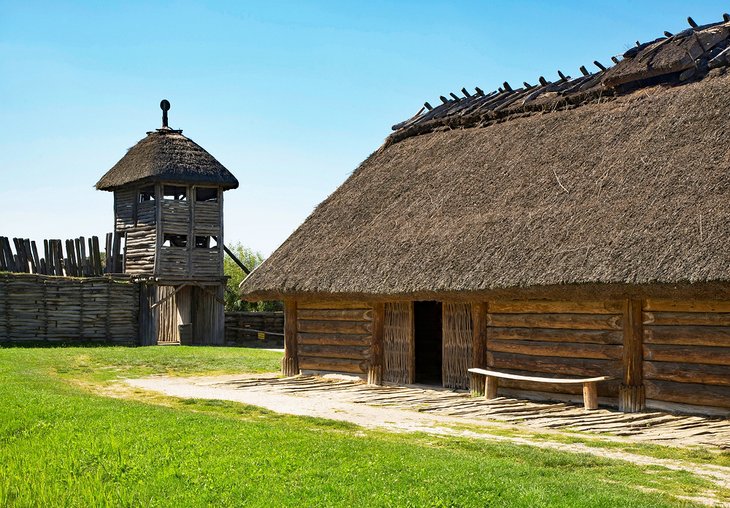
Often referred to as "the Pompeii of Poland," the Biskupin Settlement is a recreation of the original prehistoric settlement that once thrived in the same place around the late Bronze Age.
Now an archeological open-air museum that tells the story of ancient Poland, the settlement showcases what life would have been like back then, with log houses (the original settlement included over 100 homes) and streets covered with wooden planks (as the location meant the streets were always wet and the ground always soft).
The settlement is surrounded by a tall wooden wall that's over 450 meters long and includes a watchtower near the entrance gate.
More Related Articles on PlanetWare.com
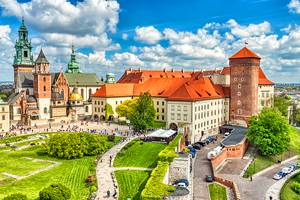
Exploring Poland: Poland is one of the top-rated cheap places to visit in Europe – it offers great food, affordable accommodations, and plenty of unique destinations. For tips on things to do when visiting, take a look at our list of the Best Places to Visit in Poland .
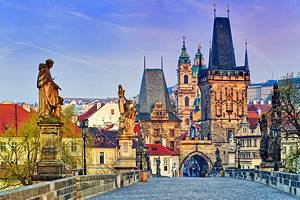
Crossing Borders: Poland is strategically located, allowing easy access to many other countries in Europe. Spend a weekend discovering the top-rated tourist attractions in the Czech Republic , just a few hours away, or head over to Germany, even closer. Take a look at the many things to do in Germany in our article, Top-Rated Tourist Attractions in Germany .

- History Classics
- Your Profile
- Find History on Facebook (Opens in a new window)
- Find History on Twitter (Opens in a new window)
- Find History on YouTube (Opens in a new window)
- Find History on Instagram (Opens in a new window)
- Find History on TikTok (Opens in a new window)
- This Day In History
- History Podcasts
- History Vault
By: History.com Editors
Updated: January 24, 2024 | Original: December 15, 2009

Auschwitz, also known as Auschwitz-Birkenau, opened in 1940 and was the largest of the Nazi concentration and death camps. Located in southern Poland, Auschwitz initially served as a detention center for political prisoners. However, it evolved into a network of camps where Jewish people and other perceived enemies of the Nazi state were exterminated, often in gas chambers, or used as slave labor. Some prisoners were also subjected to barbaric medical experiments led by Josef Mengele (1911-79). During World War II (1939-45), more than 1 million people, by some accounts, lost their lives at Auschwitz.
In January 1945, with the Soviet army approaching, Nazi officials ordered the camp abandoned and sent an estimated 60,000 prisoners on a forced march to other locations. When the Soviets entered Auschwitz, they found thousands of emaciated detainees and piles of corpses left behind.
Auschwitz: Genesis of Death Camps
After the start of World War II , Adolf Hitler (1889-1945), the chancellor of Germany from 1933 to 1945, implemented a policy that came to be known as the “Final Solution.” Hitler was determined not just to isolate Jews in Germany and countries annexed by the Nazis, subjecting them to dehumanizing regulations and random acts of violence. Instead, he became convinced that his “Jewish problem” would be solved only with the elimination of every Jew in his domain, along with artists, educators, Romas, communists, homosexuals, the mentally and physically handicapped and others deemed unfit for survival in Nazi Germany.
Did you know? In October 1944, a group of Auschwitz "Sonderkommando," young Jewish males responsible for removing corpses from crematoriums and gas chambers, staged a revolt. They assaulted their guards, using tools and makeshift explosives, and demolished a crematorium. All were apprehended and killed.
To complete this mission, Hitler ordered the construction of death camps. Unlike concentration camps, which had existed in Germany since 1933 and were detention centers for Jews, political prisoners and other perceived enemies of the Nazi state, death camps existed for the sole purpose of killing Jews and other “undesirables,” in what became known as the Holocaust.
Auschwitz: The Largest of the Death Camps
Auschwitz, the largest and arguably the most notorious of all the Nazi death camps, opened in the spring of 1940. Its first commandant was Rudolf Höss (1900-47), who previously had helped run the Sachsenhausen concentration camp in Oranienburg, Germany. Auschwitz was located on a former military base outside Oswiecim, a town in southern Poland situated near Krakow, one of the country’s largest cities. During the camp’s construction, nearby factories were appropriated and all those living in the area were forcibly ejected from their homes, which were bulldozed by the Nazis.
Auschwitz originally was conceived as a concentration camp, to be used as a detention center for the many Polish citizens arrested after Germany annexed the country in 1939. These detainees included anti-Nazi activists, politicians, resistance members and luminaries from the cultural and scientific communities. Once Hitler’s Final Solution became official Nazi policy, however, Auschwitz was deemed an ideal death camp locale. For one thing, it was situated near the center of all German-occupied countries on the European continent. For another, it was in close proximity to the string of rail lines used to transport detainees to the network of Nazi camps.
However, not all those arriving at Auschwitz were immediately exterminated. Those deemed fit to work were employed as slave labor in the production of munitions, synthetic rubber and other products considered essential to Germany’s efforts in World War II.
Auschwitz and Its Subdivisions
At its peak of operation, Auschwitz consisted of several divisions. The original camp, known as Auschwitz I, housed between 15,000 and 20,000 political prisoners. Those entering its main gate were greeted with an infamous and ironic inscription: “Arbeit Macht Frei,” or “Work Makes You Free.”
Auschwitz II, located in the village of Birkenau, or Brzezinka, was constructed in 1941 on the order of Heinrich Himmler (1900-45), commander of the “Schutzstaffel” (or Select Guard/Protection Squad, more commonly known as the SS), which operated all Nazi concentration camps and death camps. Birkenau, the biggest of the Auschwitz facilities, could hold some 90,000 prisoners.
It also housed a group of bathhouses where countless people were gassed to death, and crematory ovens where bodies were burned. The majority of Auschwitz victims died at Birkenau. More than 40 smaller facilities, called subcamps, dotted the landscape and served as slave-labor camps. The largest of these subcamps, Monowitz, also known as Auschwitz III, began operating in 1942 and housed some 10,000 prisoners.
Life and Death in Auschwitz
By mid-1942, the majority of those being sent by the Nazis to Auschwitz were Jews. Upon arriving at the camp, detainees were examined by Nazi doctors. Those detainees considered unfit for work, including young children, the elderly, pregnant women and the infirm, were immediately ordered to take showers. However, the bathhouses to which they marched were disguised gas chambers. Once inside, the prisoners were exposed to Zyklon-B poison gas. Individuals marked as unfit for work were never officially registered as Auschwitz inmates. For this reason, it is impossible to calculate the number of lives lost in the camp.
For those prisoners who initially escaped the gas chambers, an undetermined number died from overwork, disease, insufficient nutrition or the daily struggle for survival in brutal living conditions. Arbitrary executions, torture and retribution happened daily in front of the other prisoners.
Some Auschwitz prisoners were subjected to inhumane medical experimentation. The chief perpetrator of this barbaric research was Josef Mengele (1911-79), a German physician who began working at Auschwitz in 1943. Mengele, who came to be known as the “Angel of Death,” performed a range of experiments on detainees. For example, in an effort to study eye color, he injected serum into the eyeballs of dozens of children, causing them excruciating pain. He also injected chloroform into the hearts of twins to determine if both siblings would die at the same time and in the same manner.
Liberation of Auschwitz: 1945
As 1944 came to a close and the defeat of Nazi Germany by the Allied forces seemed certain, the Auschwitz commandants began destroying evidence of the horror that had taken place there. Buildings were torn down, blown up or set on fire, and records were destroyed.
In January 1945, as the Soviet army entered Krakow, the Germans ordered that Auschwitz be abandoned. Before the end of the month, in what came to be known as the Auschwitz death marches, an estimated 60,000 detainees, accompanied by Nazi guards, departed the camp and were forced to march to the Polish towns of Gliwice or Wodzislaw, some 30 miles away. Countless prisoners died during this process; those who made it to the sites were sent on trains to concentration camps in Germany.
When the Soviet army entered Auschwitz on January 27, they found approximately 7,600 sick or emaciated detainees who had been left behind barbed wire. The liberators also discovered mounds of corpses, hundreds of thousands of pieces of clothing and pairs of shoes and seven tons of human hair that had been shaved from detainees before their liquidation. According to some estimates, between 1.1 million to 1.5 million people, the vast majority of them Jews, died at Auschwitz during its years of operation. An estimated 70,000 to 80,000 Poles perished at the camp, along with 19,000 to 20,000 Romas and smaller numbers of Soviet prisoners of war and other individuals.
Auschwitz Today
Today, Auschwitz is open to the public as the Auschwitz-Birkenau Memorial and Museum . It tells the story of the largest mass murder site in history and acts as a reminder of the horrors of genocide.
Images from the Death Camps

Sign up for Inside History
Get HISTORY’s most fascinating stories delivered to your inbox three times a week.
By submitting your information, you agree to receive emails from HISTORY and A+E Networks. You can opt out at any time. You must be 16 years or older and a resident of the United States.
More details : Privacy Notice | Terms of Use | Contact Us
Why is Christian Science in our name?
Our name is about honesty. The Monitor is owned by The Christian Science Church, and we’ve always been transparent about that.
The Church publishes the Monitor because it sees good journalism as vital to progress in the world. Since 1908, we’ve aimed “to injure no man, but to bless all mankind,” as our founder, Mary Baker Eddy, put it.
Here, you’ll find award-winning journalism not driven by commercial influences – a news organization that takes seriously its mission to uplift the world by seeking solutions and finding reasons for credible hope.
Your subscription makes our work possible.
We want to bridge divides to reach everyone.

Get stories that empower and uplift daily.
Already a subscriber? Log in to hide ads .
Select free newsletters:
A selection of the most viewed stories this week on the Monitor's website.
Every Saturday
Hear about special editorial projects, new product information, and upcoming events.
Select stories from the Monitor that empower and uplift.
Every Weekday
An update on major political events, candidates, and parties twice a week.
Twice a Week
Stay informed about the latest scientific discoveries & breakthroughs.
Every Tuesday
A weekly digest of Monitor views and insightful commentary on major events.
Every Thursday
Latest book reviews, author interviews, and reading trends.
Every Friday
A weekly update on music, movies, cultural trends, and education solutions.
The three most recent Christian Science articles with a spiritual perspective.
Every Monday
With antisemitism on rise, Auschwitz exhibit counters with proof of Holocaust
- Deep Read ( 5 Min. )
- By Leonardo Bevilacqua Staff writer @LeonardoBevil12
April 10, 2024 | Boston
In a glass case at “Auschwitz. Not Long Ago. Not Far Away.” lie many items people carry in their purses and totes: hairbrushes, razors, glasses, loose buttons, perfume bottles. They make it easy to see the people behind the statistics.
Organizers of the exhibit aim to address rising antisemitism and denial of the Holocaust, especially since the Oct. 7 attack in Israel. On a bench in a dimly lit gallery by his mother’s yellow star, Robert Jan van Pelt, the chief curator and a professor, makes his case for relying on evidence.
Why We Wrote This
Amid the Israel-Hamas war, antisemitism and Holocaust denial have risen. An Auschwitz exhibit stands firmly for the truth by providing evidence of atrocities – and humanity.
“We basically tell our students, ‘You may have your own opinions, but you can’t have your own facts,’” says Dr. van Pelt. “We leave something to [visitors] to draw their own conclusions and narratives.”
The exhibit, currently in Boston, features some 700 artifacts from the Nazis’ largest concentration camp. On a recent visit, Nancy Harrowitz, director of Boston University’s Elie Wiesel Center for Jewish Studies, says there was a “somber hush in the air.”
“I do think that exhibits like this fight against Holocaust denial in an active and vivid way by presenting physical proof and testimonies,” she says.
In a crowded 1996 British courtroom, Robert Jan van Pelt was called on as a witness in a lawsuit to confirm this fact: Jews were systematically murdered at Auschwitz, over 1 million of them.
Historian Deborah Lipstadt had been sued for calling British academic David Irving a Holocaust denier in one of her books. So Mr. Irving sued for libel, doubling down on his denial. As a result of the testimony of Dr. van Pelt and others, Dr. Lipstadt prevailed – providing solid proof of Nazi war crimes at Auschwitz.
Decades later, Dr. van Pelt has a new task ahead of him: providing evidence of the Jewish genocide’s worst site in a traveling exhibit.
He aims to address rising antisemitism and denial of the Holocaust, especially since the Oct. 7 attack in Israel. Jews in academic settings increasingly feel sidelined in discussions of their history. In Greater Boston, for example, two separate advocacy groups led by students are suing Harvard University and the Massachusetts Institute of Technology for failing to protect Jewish students from harassment both inside and outside the classroom.
Dr. van Pelt, the chief curator of “Auschwitz. Not Long Ago. Not Far Away.” and a professor in Canada at the University of Waterloo, spoke with the Monitor at the exhibition’s latest stop in Boston. On a bench in a dimly lit gallery by his mother’s yellow star, her Dutch state ID branding her a Jew, and the fake ID she used to flee, he made his case for relying on evidence.
“We basically tell our students, ‘You may have your own opinions, but you can’t have your own facts,’” says Dr. van Pelt before turning his gaze toward the striped pajamas, the yellow star, and a giant barrack lifted from Auschwitz. “We leave something to [visitors] to draw their own conclusions and narratives.”

The exhibit features some 700 artifacts from the Nazis’ largest concentration camp. Curators say they have tried to present material in a way that accommodates visitors of all ages and backgrounds. The Liberty Mutual Foundation has paid for 10,000 schoolchildren in the area to visit the exhibition, housed at The Saunders Castle at Park Plaza through the summer.
“There was a somber hush in the air. I did not hear any conversations except in whispers, no laughter or any indication that the visitors were anything but completely immersed in the experience,” Nancy Harrowitz, director of Boston University’s Elie Wiesel Center for Jewish Studies, says of her March 17 visit. “I do think that exhibits like this fight against Holocaust denial in an active and vivid way by presenting physical proof and testimonies.”
People behind the statistics
In a glass case lie the many items people carry in their purses and totes: hairbrushes, razors, pocketbooks, glasses, loose buttons, hand mirrors, compacts, and cologne and perfume bottles. They make it easy to see the people behind the statistics.
Isabella Nguyen, a young professional in media, and her millennial friend group stopped by after work to better understand a moment in history amid trending discussion of genocide and antisemitism.
“I’ve been [at the exhibit] for three hours with my friends. It’s a testament to how detailed” it is, Ms. Nguyen says. “They went into the history and political background of the climate and where it started. The situation was similar [to now].”
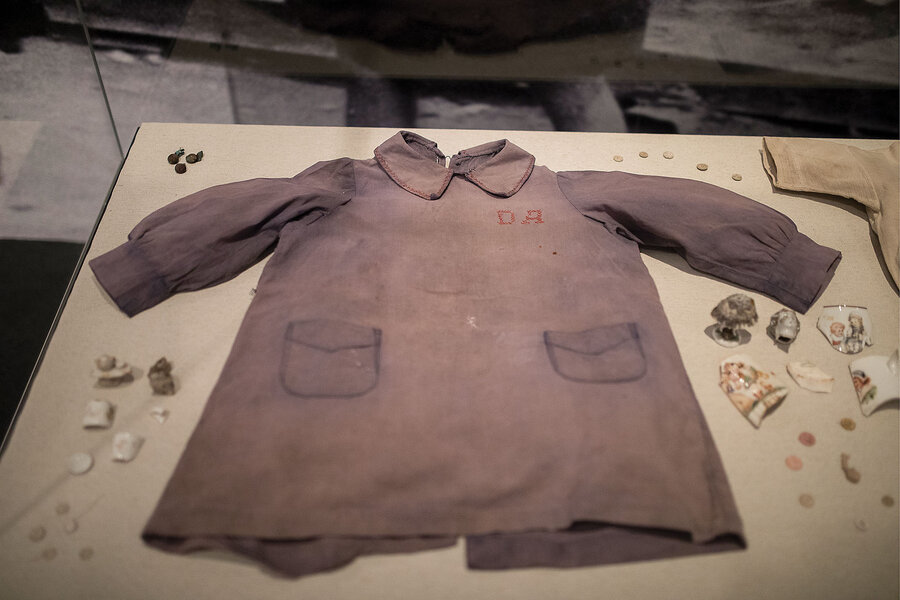
“Auschwitz didn’t happen in a vacuum”
Antisemitism emerged strongly during an economic downturn in Germany in the 1930s. A small plaque enlightens visitors that Germany’s currency, the deutsche mark, was informally referred to as “Jewish confetti” – a dig at the background of the finance minister who eventually did rein in hyperinflation.
“I think giving context not only to the Nazi ideology but also of the duration of [its] power is important,” says Paweł Sawicki, a spokesperson for the Auschwitz-Birkenau State Museum in Poland. “Auschwitz didn’t happen in a vacuum.”
In one gallery, Jewish rituals and talismans are explained, speaking to the rich cultural life that existed in pre-Holocaust Poland in the city of Oświęcim, or Auschwitz. Resting inside a glass case is a tallit – a thin religious cloth traditionally worn by Jews in prayer and during burial. The people who gained a reputation for their “odd customs,” one wall plaque states, stuck out in European society.
“Most exhibits do not have much focus on what Jewish life was like before the Nazi destruction,” says Dr. Harrowitz. “The inclusion of this material helped to humanize Jewish populations, encouraging empathy for the victims, rather than just understanding them as faceless numbers.”
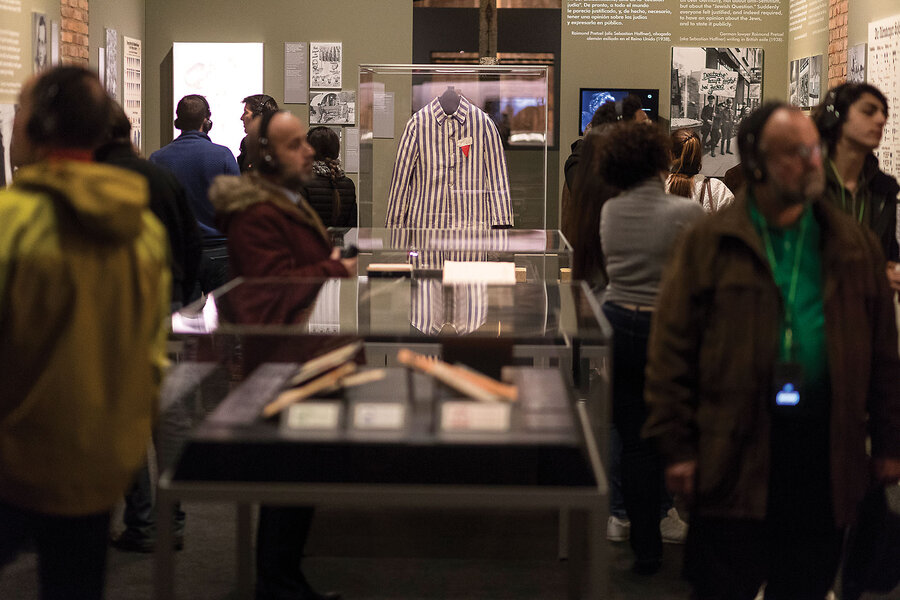
How do you hold on to humanity in degrading conditions? Isabella Ribinstajn, a teenage Auschwitz prisoner, wore a pink slip under her uniform each day, preserving some sense of a normal girlhood. Its frayed cloth now sits under a dim light for other young girls to see.
“My students didn’t know the levels of resistance that people performed. These acts of resistance ... were new to them,” says Sarah Barbato, a history teacher who took her class from Souhegan High School in Amherst, New Hampshire.
Teachers are up against an influx of disinformation, says Ms. Barbato. “Denial is the final step of genocide,” which she makes sure to remind her students. She and a fellow educator, Aimee Gibbons, strive to steer their students toward the facts and away from digital propaganda.
On social media, an incubator of cultural pessimism, antisemitism will find a home in the hearts of those who are looking for a convenient scapegoat for global disorder, Dr. Harrowitz explains. “The retelling of the old and vicious antisemitic myths about Jews and power make young people more vulnerable to believing misinformation about the Holocaust,” says Dr. Harrowitz.
Rooms of context and glass cases of personal belongings build to a confrontation with the Nazis’ instrument of mass murder, cyanide-based pesticide. Canisters of Zyklon B look like charred cans of spray paint to the untrained eye. A gas mask beside them makes their purpose unmistakable. Here was the proof that held up as Dr. van Pelt took the stand against Holocaust denial.
By slowing down and sampling maybe four, five, or six artifacts in the exhibit, you get an impression of the horror, Dr. van Pelt remarks as he walks between galleries that are bounded by transported fence posts – rusted wire limp at their sides. “This idea that people are willing to immerse themselves in a difficult story is important – and [that they] are willing to give it some thought,” he says.
Editor’s note: This story has been updated to delete references to a 2023 Economist/YouGov survey about 20% of young Americans being Holocaust deniers. The survey’s opt-in methodology has been shown to be flawed.
Help fund Monitor journalism for $11/ month
Already a subscriber? Login

Monitor journalism changes lives because we open that too-small box that most people think they live in. We believe news can and should expand a sense of identity and possibility beyond narrow conventional expectations.
Our work isn't possible without your support.
Unlimited digital access $11/month.

Digital subscription includes:
- Unlimited access to CSMonitor.com.
- CSMonitor.com archive.
- The Monitor Daily email.
- No advertising.
- Cancel anytime.

Related stories
German reparations for holocaust reveal complexities of atonement, protesters of israel-hamas war fear nuance is getting lost, toronto film fest: big-screen gems, absent movie stars, share this article.
Link copied.
Give us your feedback
We want to hear, did we miss an angle we should have covered? Should we come back to this topic? Or just give us a rating for this story. We want to hear from you.
Dear Reader,
About a year ago, I happened upon this statement about the Monitor in the Harvard Business Review – under the charming heading of “do things that don’t interest you”:
“Many things that end up” being meaningful, writes social scientist Joseph Grenny, “have come from conference workshops, articles, or online videos that began as a chore and ended with an insight. My work in Kenya, for example, was heavily influenced by a Christian Science Monitor article I had forced myself to read 10 years earlier. Sometimes, we call things ‘boring’ simply because they lie outside the box we are currently in.”
If you were to come up with a punchline to a joke about the Monitor, that would probably be it. We’re seen as being global, fair, insightful, and perhaps a bit too earnest. We’re the bran muffin of journalism.
But you know what? We change lives. And I’m going to argue that we change lives precisely because we force open that too-small box that most human beings think they live in.
The Monitor is a peculiar little publication that’s hard for the world to figure out. We’re run by a church, but we’re not only for church members and we’re not about converting people. We’re known as being fair even as the world becomes as polarized as at any time since the newspaper’s founding in 1908.
We have a mission beyond circulation, we want to bridge divides. We’re about kicking down the door of thought everywhere and saying, “You are bigger and more capable than you realize. And we can prove it.”
If you’re looking for bran muffin journalism, you can subscribe to the Monitor for $15. You’ll get the Monitor Weekly magazine, the Monitor Daily email, and unlimited access to CSMonitor.com.
Subscribe to insightful journalism
Subscription expired
Your subscription to The Christian Science Monitor has expired. You can renew your subscription or continue to use the site without a subscription.
Return to the free version of the site
If you have questions about your account, please contact customer service or call us at 1-617-450-2300 .
This message will appear once per week unless you renew or log out.
Session expired
Your session to The Christian Science Monitor has expired. We logged you out.
No subscription
You don’t have a Christian Science Monitor subscription yet.
- Krakow Tourism
- Krakow Hotels
- Krakow Bed and Breakfast
- Krakow Vacation Rentals
- Flights to Krakow
- Krakow Restaurants
- Things to Do in Krakow
- Krakow Travel Forum
- Krakow Photos
- All Krakow Hotels
- Krakow Hotel Deals
- Last Minute Hotels in Krakow
- Krakow Motels
- Krakow Campgrounds
- Krakow Hostels
- Krakow Business Hotels
- Krakow Family Hotels
- Romantic Hotels in Krakow
- Krakow Spa Resorts
- Krakow Green Hotels
- Krakow Luxury Hotels
- Krakow Casinos
- 5-stars Hotels in Krakow
- 4-stars Hotels in Krakow
- 3-stars Hotels in Krakow
- ibis Hotels in Krakow
- Wyndham Hotels in Krakow
- Marriott Hotels in Krakow
- Louvre Hotels in Krakow
- Novotel Hotels in Krakow
- Golden Tulip Hotels in Krakow
- Best Western Hotels in Krakow
- Q Hotels in Krakow
- Campanile Hotels in Krakow
- Leonardo Hotels in Krakow
- InterContinental (IHG) Hotels in Krakow
- Hilton Hotels in Krakow
- Pet Friendly Hotels in Krakow
- Krakow Hotels with Pools
- Krakow Hotels with Free Parking
- Stare Miasto Hotels
- Kazimierz Hotels
- Wesola Zachod Hotels
- Kleparz Hotels
- Polwsie Zwierzynieckie Hotels
- Stare Podorze Hotels
- Stradom Hotels
- Czarna WieS Hotels
- Krakow Cheap Hotels
- Krakow Apartment Hotels
- Boutique Hotels in Krakow
- Krakow City Center Hotels
- Krakow Hotels with Hot Tubs
- Krakow Hotels with Balconies
- Romantic Boutique Hotels in Krakow
- Luxury Spa Hotels in Krakow
- Boutique Spa Hotels in Krakow
- Krakow Luxury Boutique Hotels
- Hotels near Krakow's Rynek Glowny Central Square
- Hotels near Muzeum Krakowa, oddzial Fabryka Emalia Oskara Schindlera
- Hotels near Wawel Royal Castle
- Hotels near Kazmierz The Former Jewish District
- Hotels near Stare Miasto
- Hotels near St Mary's Basilica
- Hotels near Wawel Cathedral
- Hotels near Krakow Auschwitz - Tours
- Hotels near Sukiennice (Cloth Hall)
- Hotels near Krakow Tours by KrakowDirect
- Hotels near Muzeum Krakowa - Rynek Podziemny
- Hotels near GR8WAY
- Hotels near Auschwitz Tour - Krakow Trip
- Hotels near Lost Souls Alley
- Hotels near (KRK) J. Paul II Balice Intl Airport
- Hotel Xcaret Mexico
- Secrets Cap Cana Resort & Spa
- Jules Undersea Lodge
- Horseshoe Las Vegas
- Excellence Playa Mujeres
- ARIA Resort & Casino
- Barcelo Bavaro Palace All Inclusive Resort
- Dreams Macao Beach Punta Cana
- Flamingo Las Vegas
- Bellagio Las Vegas
- Beaches Turks & Caicos
- Hilton Cancun, an All-Inclusive Resort
- Moon Palace The Grand - Cancun
- Moon Palace Jamaica
- Mohonk Mountain House
- Popular All-Inclusive Resorts
- Popular Beach Resorts
- Popular Family Resorts
- Popular All-Inclusive Hotels
- Popular Hotels With Waterparks
- Popular Honeymoon Resorts
- Popular Luxury Resorts
- Popular All-Inclusive Family Resorts
- Popular Golf Resorts
- Popular Spa Resorts
- Popular Cheap Resorts
- All things to do in Krakow
- Things to do near J. Paul II Balice Intl Airport
- Things to do near Krakow Glowny Station
- Things to do near Unique Cracow
- Things to do near Enjoy Polen
- Krakow's Rynek Glowny Central Square
- Kazmierz The Former Jewish District
- St Mary's Basilica
- Stare Miasto
- Wawel Royal Castle
- Lost Souls Alley
- Wawel Cathedral
- Muzeum Krakowa - Rynek Podziemny
- Krakow Pinball Museum
- Polish Aviation Museum
- Muzeum Krakowa, oddzial Fabryka Emalia Oskara Schindlera
- Krakil Museum of Illusions
- The Ghetto Heroes Square
- muWi Stained Glass Museum (Muzeum Witrazu)
- Sukiennice (Cloth Hall)
- Factory Tours in Krakow
- Bus Tours in Krakow
- Scuba & Snorkeling in Krakow
- Coffee & Tea Tours in Krakow
- Balloon Rides in Krakow
- Bike Tours in Krakow
- Eco Tours in Krakow
- Running Tours in Krakow
- Air Tours in Krakow
- Private Tours in Krakow
- Rail Tours in Krakow
- Zipline & Aerial Adventure Parks in Krakow
- Photography Tours in Krakow
- Canyoning & Rappelling Tours in Krakow
- Distillery Tours in Krakow
- Architectural Buildings in Krakow
- Castles in Krakow
- Civic Centers in Krakow
- Educational sites in Krakow
- Fountains in Krakow
- Government Buildings in Krakow
- Historic Sites in Krakow
- Military Bases & Facilities in Krakow
- Mysterious Sites in Krakow
- Neighborhoods in Krakow
- Observation Decks & Towers in Krakow
- Arenas & Stadiums in Krakow
- Points of Interest & Landmarks in Krakow
- Lookouts in Krakow
- Universities & Schools in Krakow
- Tramways in Krakow
- Mass Transportation Systems in Krakow
- Taxis & Shuttles in Krakow
- Bus Transportation in Krakow
- Bars & Clubs in Krakow
- Blues Clubs & Bars in Krakow
- Cigar Bars in Krakow
- Gay Clubs & Bars in Krakow
- Jazz Clubs & Bars in Krakow
- Karaoke Bars in Krakow
- Piano Bars in Krakow
- Comedy Clubs in Krakow
- Dance Clubs & Discos in Krakow
- Coffeehouses in Krakow
- Wine Bars in Krakow
- Bar, Club & Pub Tours in Krakow
- Playgrounds in Krakow
- Movie Theaters in Krakow
- Game & Entertainment Centers in Krakow
- Bowling Alleys in Krakow
- Sports Complexes in Krakow
- Room Escape Games in Krakow
- Scavenger Hunts in Krakow
- Shooting Ranges in Krakow
- Mini Golf in Krakow
- Paint & Pottery Studios in Krakow
- Golf Courses in Krakow
- Horseback Riding Tours in Krakow
- Hiking Trails in Krakow
- Sports Camps & Clinics in Krakow
- Boat Tours in Krakow
- Water Sports in Krakow
- Safaris in Krakow
- Art Galleries in Krakow
- Antique Stores in Krakow
- Department Stores in Krakow
- Factory Outlets in Krakow
- Flea & Street Markets in Krakow
- Shopping Malls in Krakow
- Gift & Specialty Shops in Krakow
- Farmers Markets in Krakow
- Shopping Tours in Krakow
- Airport Shops in Krakow
- Spas in Krakow
- Health/Fitness Clubs & Gyms in Krakow
- Hammams & Turkish Baths in Krakow
- Thermal Spas in Krakow
- Yoga & Pilates in Krakow
- Hair & Nail Salons in Krakow
- Art Museums in Krakow
- Children's Museums in Krakow
- History Museums in Krakow
- Military Museums in Krakow
- Natural History Museums in Krakow
- Science Museums in Krakow
- Specialty Museums in Krakow
- Beaches in Krakow
- Caverns & Caves in Krakow
- Deserts in Krakow
- Forests in Krakow
- Gardens in Krakow
- Geologic Formations in Krakow
- Nature & Wildlife Areas in Krakow
- Parks in Krakow
- State Parks in Krakow
- Biking Trails in Krakow
- Aquariums in Krakow
- Zoos in Krakow
- Bodies of Water in Krakow
- Wineries & Vineyards in Krakow
- Breweries in Krakow
- Beer Tastings & Tours in Krakow
- Cooking Classes in Krakow
- Food Tours in Krakow
- Wine Tours & Tastings in Krakow
- Performances in Krakow
- Concerts in Krakow
- Operas in Krakow
- Symphonies in Krakow
- Theaters in Krakow
- Cabarets in Krakow
- Lessons & Workshops in Krakow
- Boat Rentals in Krakow
- Gondola Cruises in Krakow
- Kayaking & Canoeing in Krakow
- River Rafting & Tubing in Krakow
- Stand-Up Paddleboarding in Krakow
- Sporting Events in Krakow
- Cultural Events in Krakow
- Exhibitions in Krakow
- Music Festivals in Krakow
- Things to do near ibis Styles Krakow East
- Sintra : Pena Park and Palace Entrance Tickets
- Clear kayak Drone photoshoot
- Monkeyland and Plantation Safari Tour from Punta Cana
- Nice to St Tropez Ferry Ticket and Cruise
- Cliffs of Moher Tour Including Wild Atlantic Way and Galway City from Dublin
- Jurassic Adventure Tour at Kualoa Ranch
- America's Got Talent Presents Superstars Live! at the Luxor Hotel and Casino
- XXXX Brewery Tour
- The Original Sound of Music Tour in Salzburg
- Surfside Beach
- Sex Machines Museum
- Ark Encounter
- Therme Bucuresti
- Red Light District
- The Pink Street
- Walter White’s House
- World's Largest Entertainment McDonald's & PlayPlace
- Dalma Island
- GreenLeaders
- Things to Do
- Restaurants
- Vacation Rentals
- Travel Stories
- Rental Cars
- Add a Place
- Travel Forum
- Travelers' Choice
- Help Center
THE 10 BEST Things to Do Near Auschwitz Tour
- Europe
- Poland
- Southern Poland
- Lesser Poland Province
- Krakow
- Things to Do in Krakow
- Things to do near Auschwitz Tour
Things to Do near Auschwitz Tour
Trusted reviews and ratings, free 24-hour cancellation, low-price guarantee.
- Auschwitz and Birkenau Fully Guided Tour from Krakow
- Auschwitz-Birkenau Memorial and Museum Guided Tour from Krakow
- Auschwitz-Birkenau and Wieliczka Salt Mine Guided One Day Tour
- Zakopane Tour and Thermal Hot Bath Pool with Krakow Hotel Pickup
- Day Trip to Auschwitz-Birkenau and Wieliczka Salt Mine from Krakow including Lunch
- (3.95 mi) Mojitos Casa Latina Bar & Club
- (4.11 mi) TRZCINA Bar
- (3.98 mi) Wódka Cafe Bar
- (3.84 mi) The Moon Shisha Bar
- (4.04 mi) Alchemia
- Bars & Clubs
- Private Tours
- Taxis & Shuttles
- Gift & Specialty Shops
- Discover over 1,000 restaurants near Auschwitz Tour
- Discover over 1,000 hotels near Auschwitz Tour

Four Polish Prisoners Escaped from Auschwitz In a Kommander's Personal Vehicle
T here are very few who managed to escape from Auschwitz. Those who did were often recaptured and forced to contend with horrible - and often fatal - punishments, the same fate met by those who were caught during their attempts. One of the most successful escapes from the camp occurred on June 20, 1942, when four Polish prisoners drove out the front gates, without a single shot being fired.
The prisoners involved
Kazimierz Piechowski was a Boy Scout from the Second Polish Republic. Following the collapse of the Polish resistance as a result of the German invasion of Poland , he was arrested in his hometown of Tczew and forced to work in a group clearing debris along the railway bridge over the Vistula River .
Piechowski eventually left Poland and tried to flee to France . Unfortunately, he was captured while crossing into Hungary , beginning his journey through the Third Reich 's prison system. He was sent to a Gestapo prison in Baligrod, after which he served stints in Sanok and Kraków. Prior to being sent to Auschwitz on June 20, 1940, he was imprisoned at Wiśnicz.
Not much is known of Piechowski's three accomplices prior to their imprisonment. Jósef Lempart was a priest from Wadowice, while Eugeniusz Bendera worked as an auto mechanic in Czortków. Stanisław Gustaw Jaster was a veteran of the German invasion of Poland, and while at Auschwitz served as a member of ZOW, an underground resistance movement at the camp.
A daring escape
The escape was planned after it was learned Bendera was to be executed. He wanted to ensure the plan would be successful, but was also aware of the German concept of "collective responsibility," wherein others could be accused of aiding in the escape. Once he and Piechowski were sure no one else could be implicated, they, along with Lempart and Jaster, prepared for the big event.
On June 20, 1942, the escape commenced. As he had the best grasp of the German language, Piechowski was given command. To get to the warehouse where they intended to steal SS uniforms, they took a cart and disguised themselves as a work group - a Rollwagen Kommando - which typically consisted of four-to-12 inmates pulling a freight car.
After bypassing the guards, they went about the second half of their task. Piechowski, Jaster and Lempart entered the warehouse via a coal bunker, which the former had altered to ensure it wouldn't self-latch, and broke into the room containing the uniforms and weapons . After donning their disguises, they grabbed eight grenades and four machine guns .
While this was happening, Bendera snuck into the motor pool, where he stole the Steyr 220 belonging to SS- Hauptsturmführer Paul Kreuzmann (some sources say Rudolf Höss). He knew exactly which vehicle to steal, as he'd been allowed to test drive the cars around the camp, given his background as a mechanic. He then picked up the others, grabbed a uniform and drove toward the front gate.
Fear set in as they approached the main gate bearing the Arbeit Macht Frei phrase. When it didn't open, the car came to a stop, prompting Piechowski to lean out just far enough for the guard to see his SS insignia and rank. He then yelled at him to open the gate. Once open, they drove off, never returning.
Freedom from Auschwitz
While the four evaded Auschwitz following their escape, their families weren't so lucky. In retaliation, Piechowski and Jaster's parents were imprisoned at the camp, as was Lempart's mother, where they perished. The kapo in charge of the motor pool, Kurt Pachala, was also punished following an investigation. Based on circumstantial evidence, he was tortured and sent to the standing cell in Block 11, where he died of hunger and thirst.
Along with reprisals against the group's family members, it's alleged the escape led to the use of prisoner tattoos at the camp.
Piechowski made his way to Ukraine , but due to anti-Polish sentiment was unable to find refuge. Using a fake name and forged documents, he returned to Tczew, where he found work as a farm laborer and eventually made contact with the Polish Home Army. Following the war, he was denounced by Poland's communist regime for being a member of the Home Army and sentenced to 10 years in prison, of which he served seven.
Once Poland had undergone its democratic transition, he was offered the Order of the White Eagle from Maciej Płażyński. He declined, saying, "I do not feel that this honor is owed to me."
Bendera returned to Przedbórz, where he lived with his wife until their divorce, after which he moved to Warsaw. Lempart was dropped off at a monastery in Stary Sącz, 155 KM from Auschwitz, where he remained until he left the priesthood.
Jaster reported to the Home Army Command with a report he'd snuck out of Auschwitz, and fought with one of its special operations units, the Organizacja Specjalnych Akcji Bojowych. He also participated in engagements by other units. Most notable was the freeing of Auschwitz-bound prisoners at the Celestynów railway junction on May 19, 1943.
Want War History Online 's content sent directly to your inbox? Sign up for our newsletter here!
On July 12, 1943, Jaster was arrested by the Gestapo in Warsaw. While the circumstances surrounding his death are debated, it's believed he died in custody between July and September of that year.
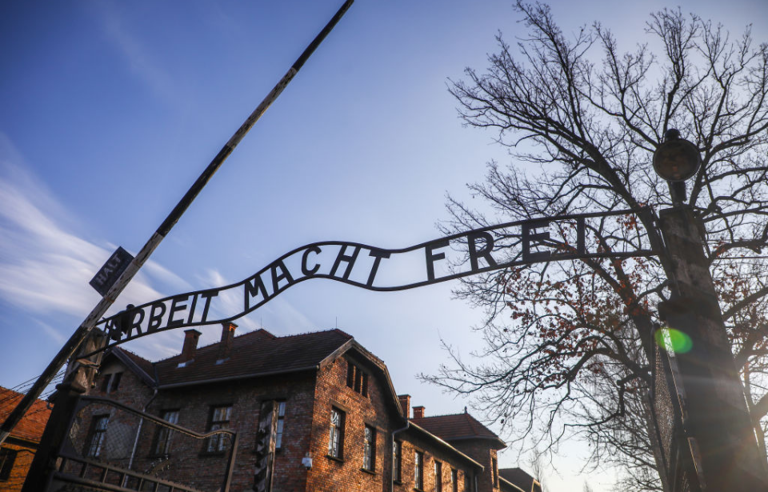

IMAGES
VIDEO
COMMENTS
Before the visit please read " the rules for visiting ". • The grounds and buildings of the Auschwitz I and Auschwitz II-Birkenau camps are open to visitors. The duration of a visit is determined solely by the individual interests and needs of the visitors. As a minimum, however, at least three-and-a-half hours should be reserved.
7:30-19:00 in June, July, and August. The closing time means the last entrance - after that, you are allowed to stay on-site for an hour and a half. However, if you want to see Auschwitz Museum properly, you need at least 3,5 hours for that - that's also how long the standard tour with the educator lasts.
Things to Do in Oswiecim, Poland: See Tripadvisor's 20,388 traveler reviews and photos of Oswiecim tourist attractions. Find what to do today, this weekend, or in April. ... many Jews, Poles and gypsies died here. The museum consists of two parts: Auschwitz I, the first and oldest camp (the number of prisoners fluctuated around 15,000 ...
KL Auschwitz was the largest of the German Nazi concentration camps and extermination centers. Over 1.1 million men, women and children lost their lives here. Visiting. The authentic Memorial consists of two parts of the former camp: Auschwitz and Birkenau. A visit with an educator allows better understanding of this unique place.
Things to Do in Oswiecim, Poland: See Tripadvisor's 20,378 traveller reviews and photos of Oswiecim tourist attractions. Find what to do today, this weekend, or in April. ... many Jews, Poles and gypsies died here. The museum consists of two parts: Auschwitz I, the first and oldest camp (the number of prisoners fluctuated around 15,000 ...
The Auschwitz-Birkenau Memorial and Museum is free to visit every day between 7:30 a.m. and 3:30 p.m., but most months offer extended hours. (Note: Visitors will not be admitted up to 90 minutes ...
Experience. This tour features a visit to Auschwitz, the largest Nazi concentration camp from World War II. See the gas chambers, crematorium and death cells. After pickup at 6:00 AM, you'll be transferred to Warsaw Central Railway Station. Go by train to Krakow Main Railway Station, a journey of approximately 2.5 hours.
The huge Birkenau camp (same hours as Auschwitz) was designed as a death camp in 1942, when the Nazis decided on their policy of exterminating European Jewry. Allow 1-2 hours to fully explore the 175-hectare site. Large gas chambers at the back of the camp were damaged but not destroyed by the fleeing Nazis in 1945.
Discover Auschwitz Concentration Camp in Oswiecim, Poland: The former Nazi concentration camp stands as a museum to remember this dark chapter in European history.
Benefit from pick-up at your accommodation in Krakow, and journey by air-conditioned vehicle to Oświęcim. Enter the Auschwitz-Birkenau Memorial and Museum for a 3.5-hour guided tour of the former Nazi concentration camps. Hear how 1.3 million Jews, along with prisoners from Poland, France and Italy were murdered there during World War II.
3. Krakow: Auschwitz-Birkenau and Salt Mine Guided Tour. Take a tour from Krakow that includes visits to the memorial sites of Auschwitz and Birkenau, then continue your excursion with a visit to the salt mines. This 11-hour tour starts in the morning from a meeting point or with a convenient pickup in Krakow.
Things to Do in Auschwitz-Birkenau. A trip to Kraków provides an excellent opportunity to visit the former Nazi concentration and extermination camps at Auschwitz ( Oswiecim in Polish) and Birkenau. The camps lie about 80km (50 miles) to the west of the city and can be visited in an easy daytrip. Getting there is relatively straightforward.
Show more. We found 945 things to do for you near Auschwitz-Krakow Tours. View Map. Krakow's Rynek Glowny Central Square. 26,902 Reviews. Rynek Glowny, Krakow Poland. Experiences from $3. See 229 Experiences. Krakow Arcade Museum.
On busy days, over 30,000 tourists will walk through the grounds of Auschwitz. Dozens and dozens of tours run simultaneously through the old camp and Birkenau, a few minutes down the road. As such, they run a pretty efficient ship. When you arrive you sign up for a tour time and are equipped with a pass, headset and radio.
Engage in a sobering full day visit to Auschwitz-Birkenau, the former Nazi concentration camp complex. About this activity. Cancellation policy This activity is non-refundable. Duration 10 hours ... Cities in Poland. 1 Krakow. 2 Warsaw. 3 Gdansk. 4 Wroclaw. 5 Zakopane. 6 Katowice. 7 Sopot. 8 Chochołów.
The Auschwitz I and the Auschwitz II—Birkenau concentration camps are a different kind of must-see. Located about an hour west of Krakow, the camps offer a sobering look into the past. Between 1942 and 1944, over 900,000 Jews were brought to the camps here from German-occupied countries.
Auschwitz, the largest and arguably the most notorious of all the Nazi death camps, opened in the spring of 1940. Its first commandant was Rudolf Höss (1900-47), who previously had helped run the ...
Explore the Wieliczka Salt Mine and see the amazing chambers and original sculptures. Full description. Take a tour from Krakow that includes visits to the memorial sites of Auschwitz and Birkenau, then continue your excursion with a visit to the salt mines. This 11-hour tour starts in the morning from a meeting point or with a convenient ...
An Auschwitz exhibit stands firmly for the truth by providing evidence of atrocities - and humanity. Amid the rise in antisemitism that has sprung up since the Oct. 7 attack in Israel, he aims ...
We found 944 things to do for you near Auschwitz Tour. View Map. Park Lotników Polskich. 25 Reviews. Aleja Jana Pawla II, Krakow 99-200 Poland. Krakow Arcade Museum. 298 Reviews. Centralna 41 a, Krakow 31-586 Poland. Experiences from $20.
The prisoners involved. Kazimierz Piechowski was a Boy Scout from the Second Polish Republic. Following the collapse of the Polish resistance as a result of the German invasion of Poland, he was ...
Step into history with a visit to the Auschwitz-Birkenau memorial. Learn about the tragic history of the largest Holocaust memorial from your guide. Be picked up from the comfort of your accommodation in Krakow and board a comfortable bus for the 1.5-hour trip to the Auschwitz-Birkenau complex, a historic site that serves as an important ...